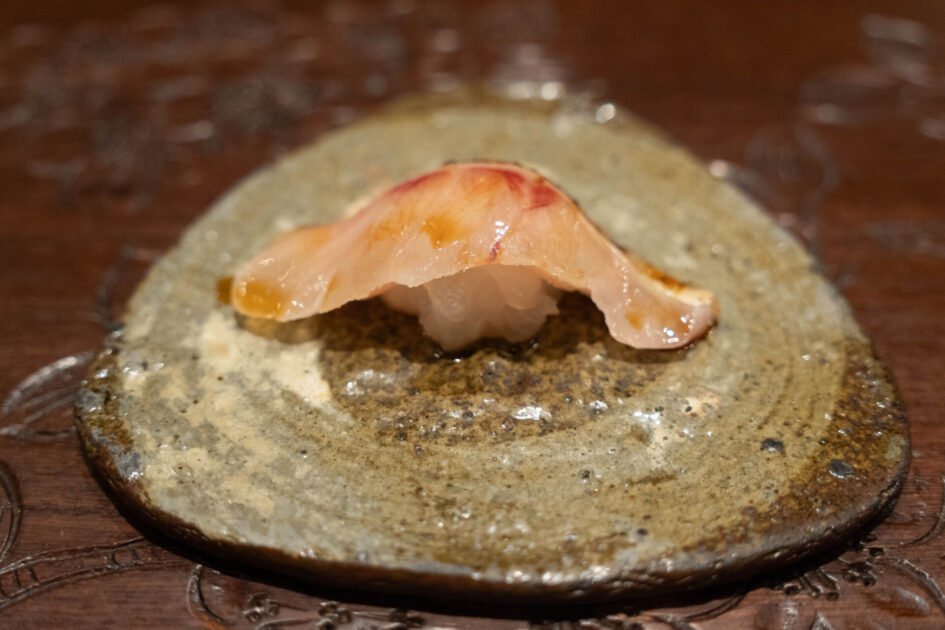CONTENTS
About Tempura Takeuchi
Concept
“Tempura Takeuchi” sits quietly in a residential neighborhood a short distance from Hakata-Minami Station in Nakagawa City, Fukuoka Prefecture. The tiny restaurant has only nine counter seats and operates by reservation only for both lunch and dinner. What’s served is a kaiseki-style course built around tempura. Conger eel (anago) and goby (haze) are filleted right before frying; fish is wild-caught, and vegetables are carefully selected domestic produce. The batter is astonishingly light, letting each ingredient’s character shine. Between the fried items come small plates of seasonal sashimi, nigiri sushi, and dishes that showcase dashi, creating a rhythm that carries you to the end. Though located in the suburbs, gourmands travel from all over Japan for the polished execution of each plate and the cohesive vision that runs through the entire meal.
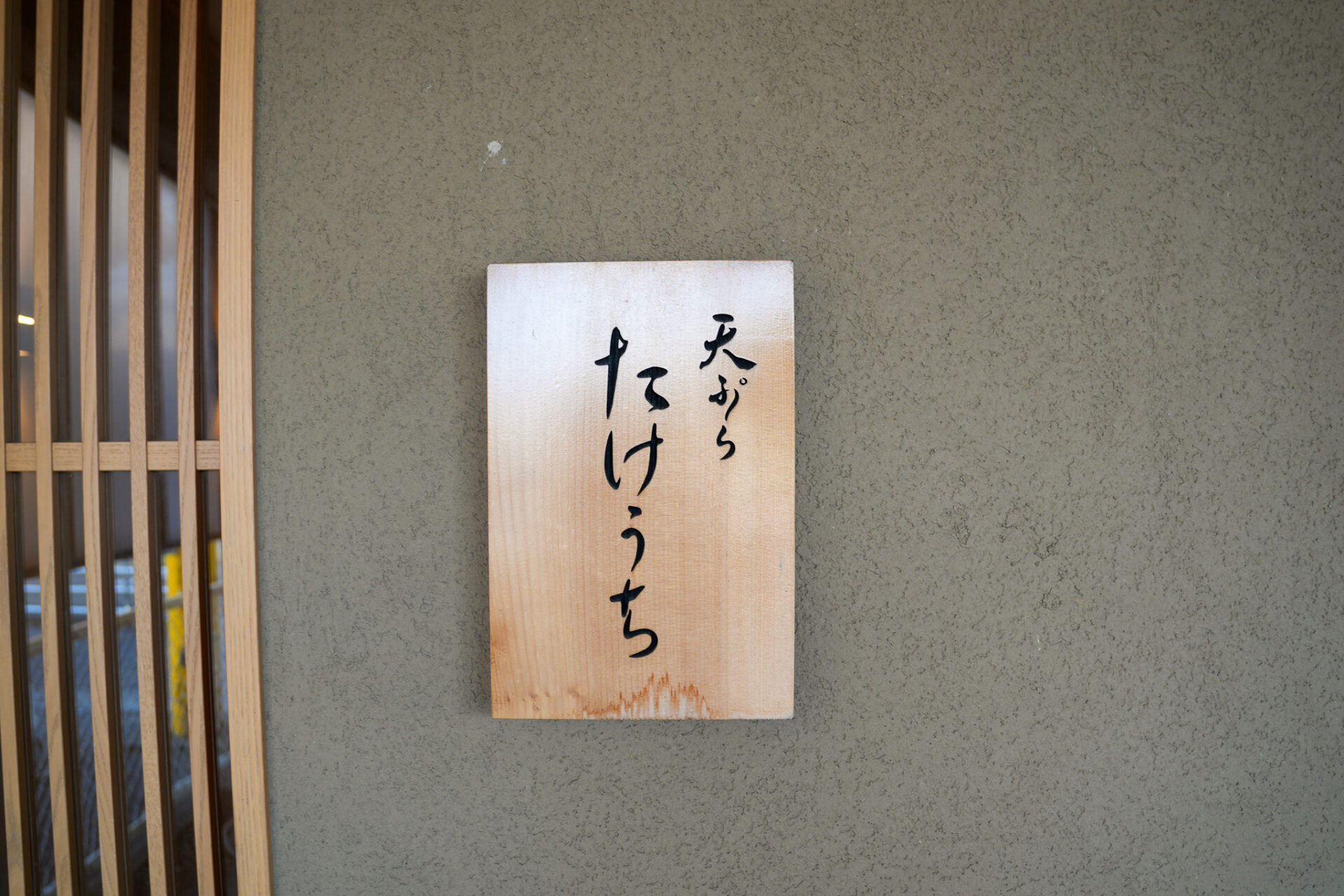
About the Chef, Takayuki Takeuchi
Chef Takayuki Takeuchi was born in Kumamoto and raised in Fukuoka. After training at an old-established Japanese restaurant in Tokyo, he opened his own place in Nakagawa at age 26. From the outset he valued being able to run everything on his own, honing his skills through self-study with tempura at the core, and eventually shaping an original course that incorporates sushi and other washoku elements. Even after 20 years since opening, he continues to pursue his ideal and refine his style day by day. That attitude is a major part of the restaurant’s appeal.
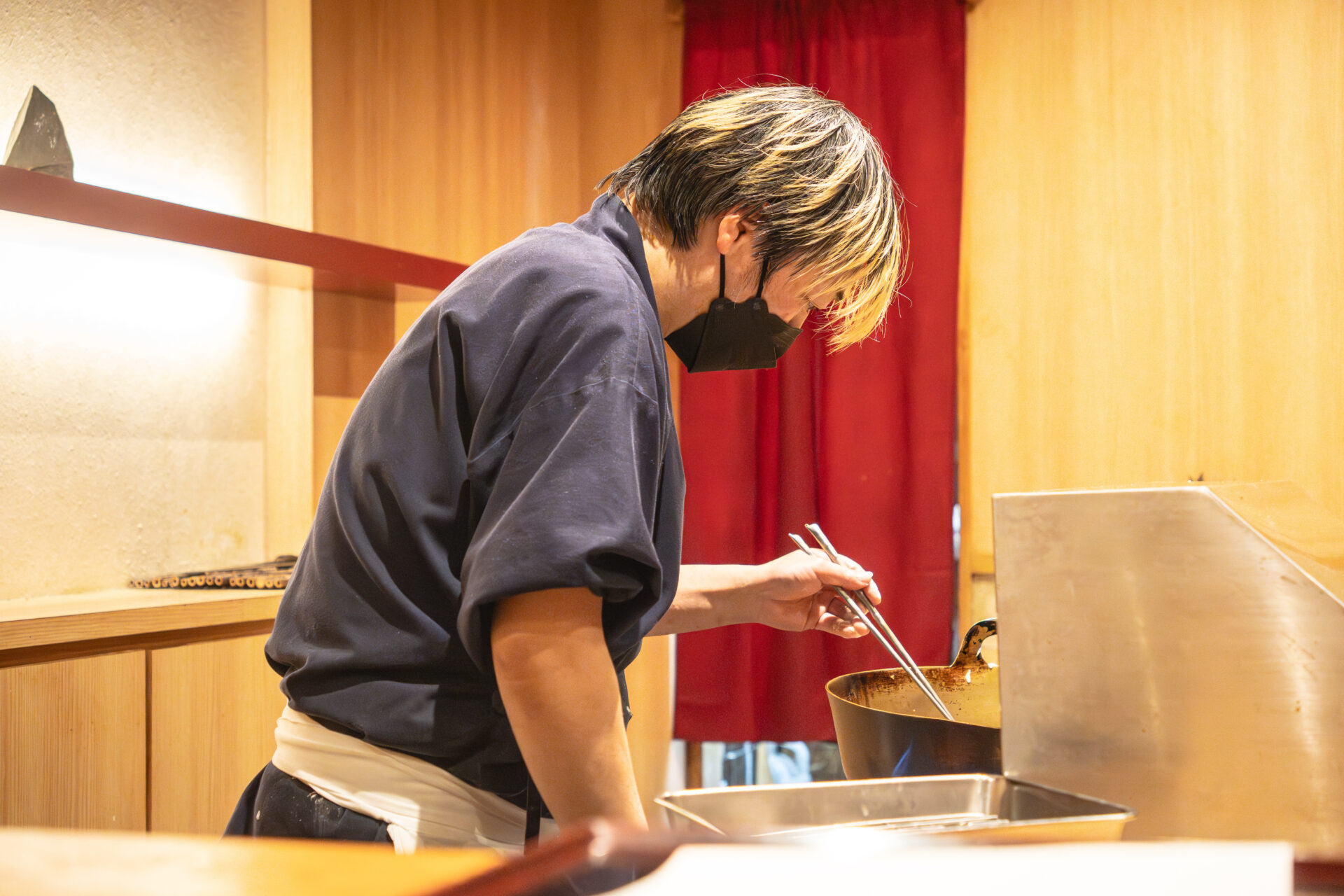
Restaurant Accolades
“Tempura Takeuchi” has been selected multiple times for Tabelog’s “Top 100 Tempura” and received the Bronze award consecutively from 2022 to 2025. It also appeared in the Michelin Guide Fukuoka–Saga (2019) with a “Michelin Plate” recommendation. While not starred, this signifies recognition by Michelin inspectors as a place “worth a visit,” drawing not only local connoisseurs but guests from across Japan. The most praised points are the lightness of the tempura, the frying that brings out the ingredients’ natural flavors, and the thoughtful flow of the course. It leaves no sense of heaviness and is often described as having a pleasant afterglow—an out-of-the-way destination with nationwide name recognition.
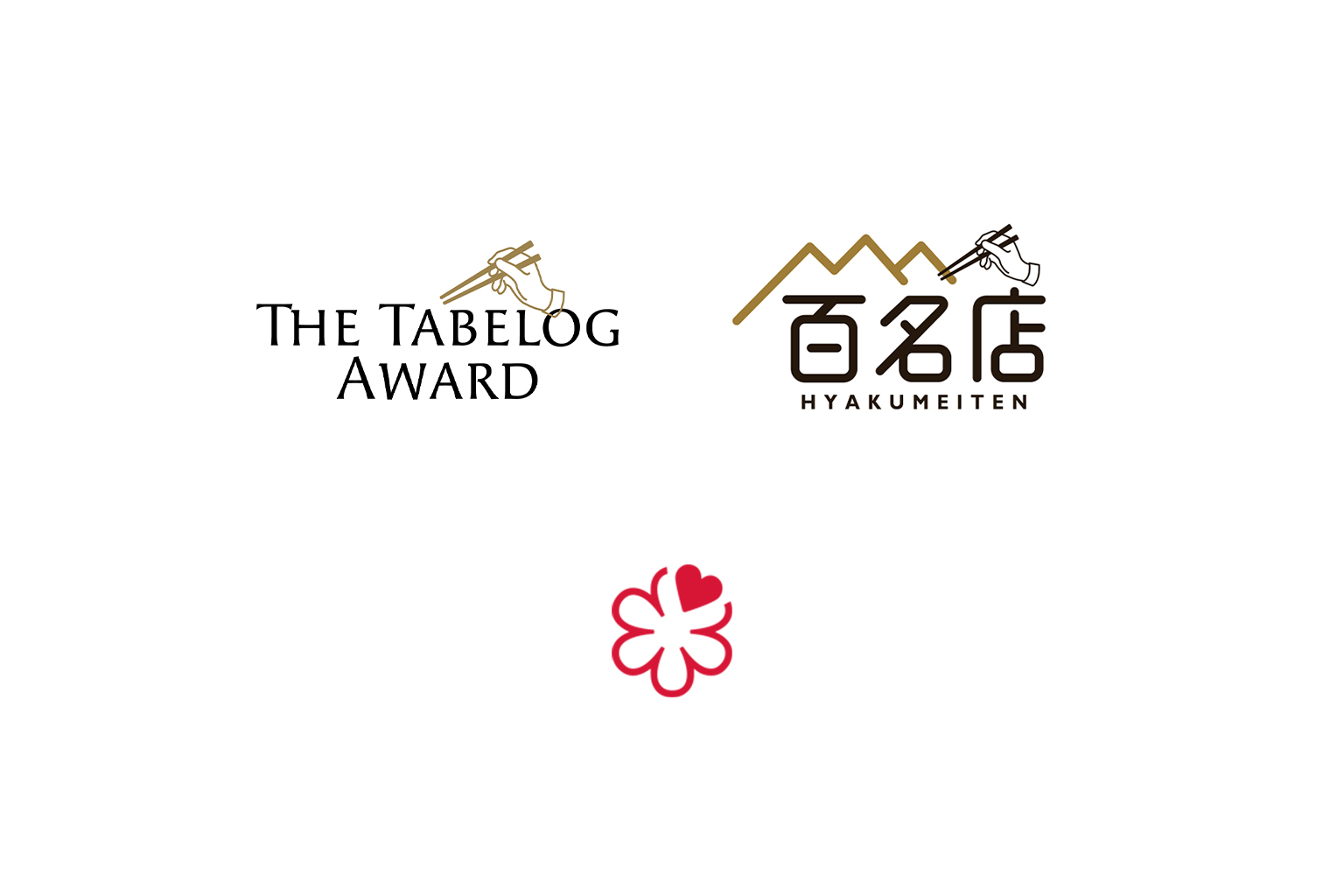
Dining Prelude
Exterior & Entrance
On the outskirts of Nakagawa City, Fukuoka, the unassuming exterior blends into what looks like an ordinary residential block. “Tempura Takeuchi” occupies a two-story house along a main road—very much a hidden gem for those in the know. Unpretentious yet quietly dignified, the setting naturally heightens your anticipation for a remarkable dining experience.

Dining Space
Inside are just nine counter seats. From the beautiful wooden counter, you can watch the chef’s hands and the fryer up close. The polished stainless-steel station softly reflects the light. A small wooden plaque engraved with “Takeuchi” rests on the back wall, and the minimalist room—free of excess decoration—spreads out before you. Red fabric curtains and indirect lighting add calm, gently directing your attention to the food.
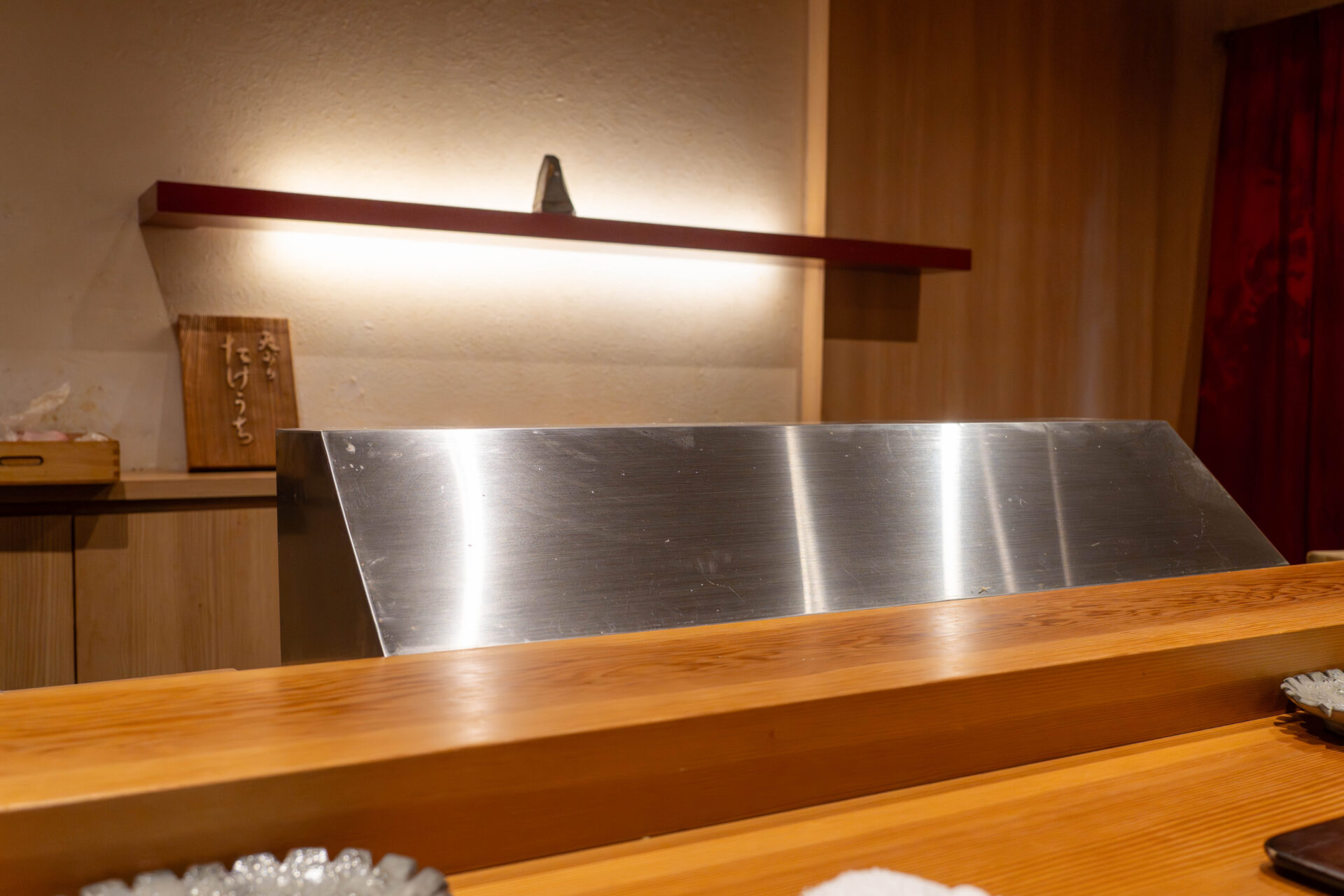
Menu Presentation
The omakase at “Tempura Takeuchi” is offered at several price points depending on ingredients and composition. For example, the ¥6,500 course centers on about ten pieces of tempura in a simple structure. The ¥8,500 course adds seasonal appetizers and nigiri sushi along with roughly ten pieces of tempura for a broader range. There is also a higher tier around ¥10,500 (¥11,550 incl. tax) that fully showcases the day’s peak-season produce. Past experiences have included seasonal selections like Ariake clams (asari) and Ishikawa rock mozuku; each dish reflects careful, detailed work.
Dishes We Tasted
Appetizer
A small bowl combining torafugu threads, Ishikawa rock mozuku, and Ariake jellyfish. The pufferfish strands coat the tongue with a silky richness, the mozuku slips down smoothly, and the jellyfish adds a lively crunch. Different textures alternate with each bite, yet gentle acidity and dashi unify the composition—an early course that leaves a vivid impression.
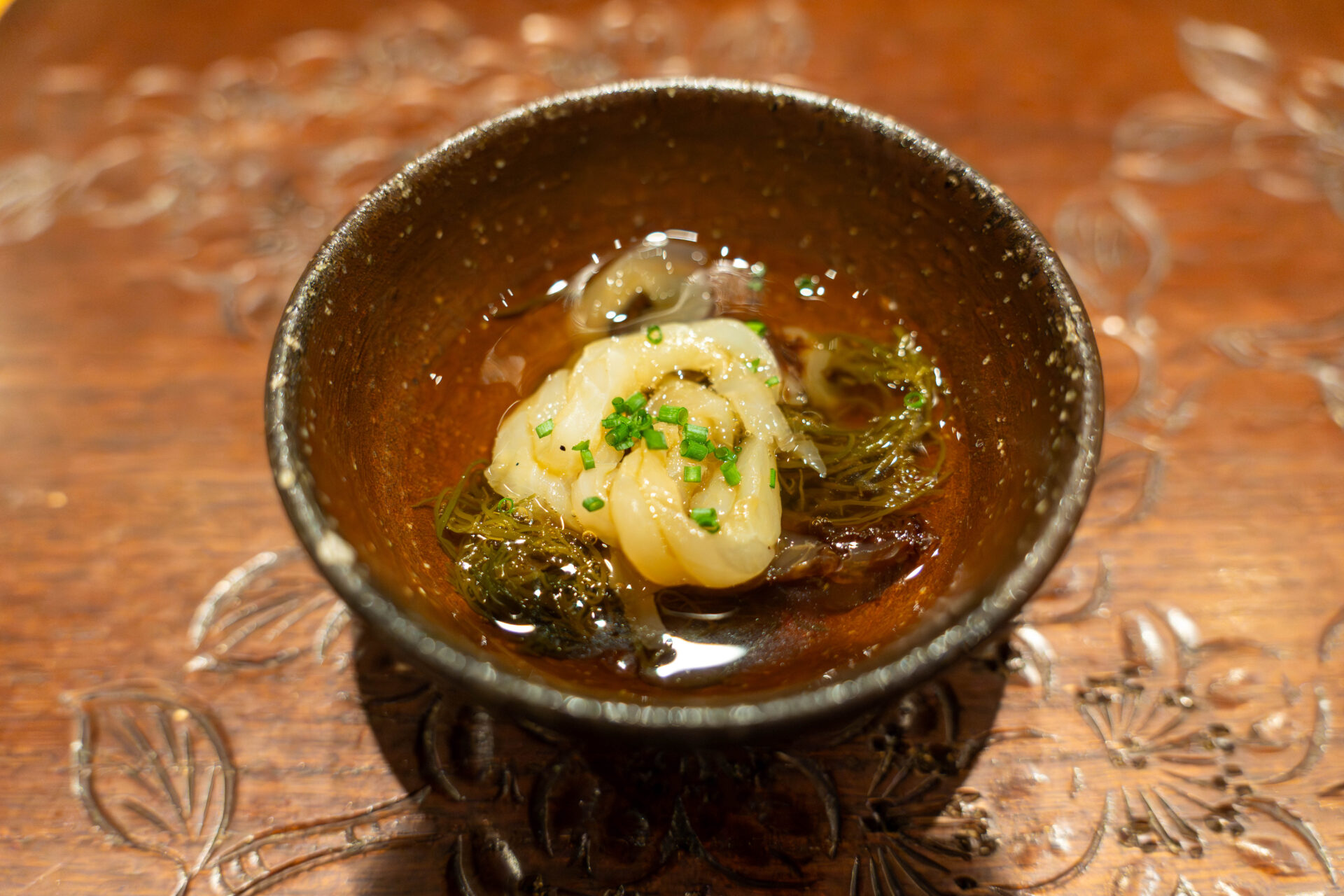
Sashimi
Freshly killed ishidai (spotted knifejaw) sliced to just the right thickness and served with wasabi. It starts with a firm bite, then releases a refined sweetness. The fat is modest but the umami is deep, neatly lifted by the aroma of wasabi. Its simplicity lays bare the fish’s condition and the precision of the chef’s work.
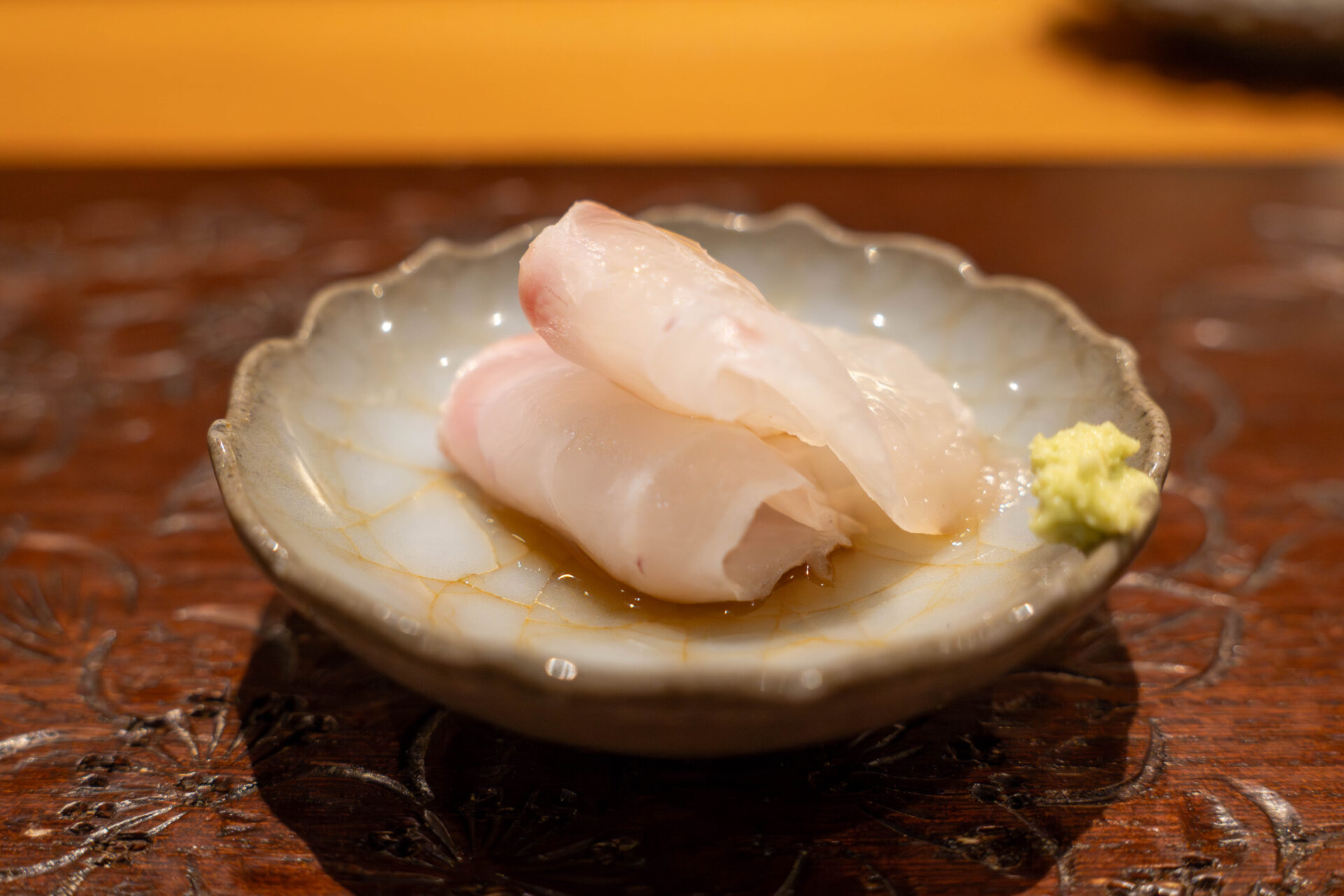
Signature: Akamutsu Kombu-Cure with Yari-ika
A single piece layering kombu-cured akamutsu (blackthroat seaperch) with yari-ika (spear squid). The akamutsu is lightly torched to add a hint of char and coax out its fat. Beneath it, the squid is finely scored for a creamy texture. The richness of akamutsu and the mellow sweetness of yari-ika overlap, the mouthfeel shifting between tenderness and a subtle spring. With each chew, flavors meld—less like “sushi” and more like tasting two bounties of the sea in one luxurious bite.
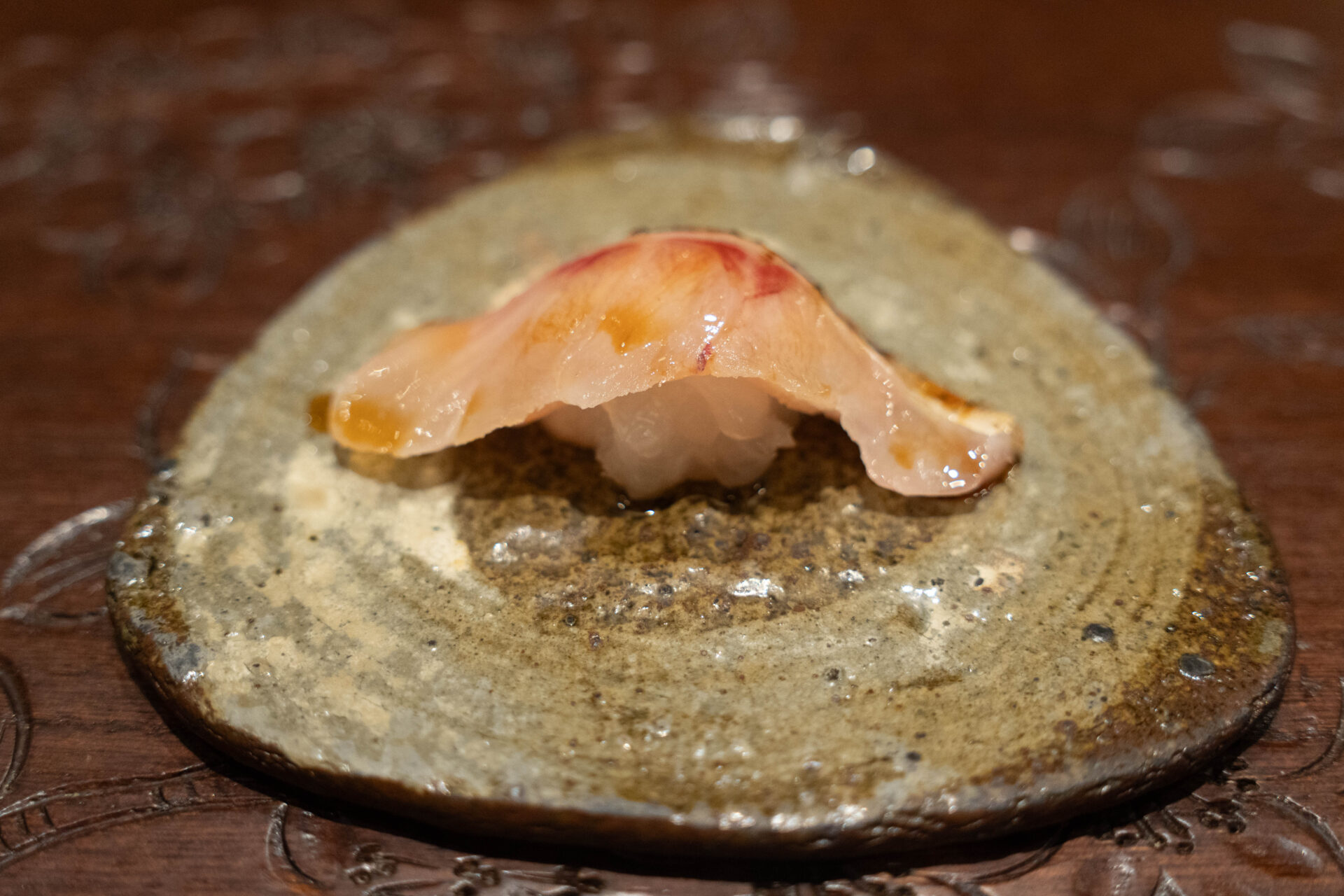
Assorted Bites
Charcoal-grilled eel from Aichi is concentrated with sweet fat and aroma; a pinch of Niyodo River sanshō from Kochi adds a refreshing finish. Smoked octopus releases savory depth with each chew while keeping a pleasant bite. Tsushima mackerel is lightly cured for balance between rich fat and acidity, and yari-ika is preserved in oil for rounded sweetness and body. One plate offers multiple faces of the sea.
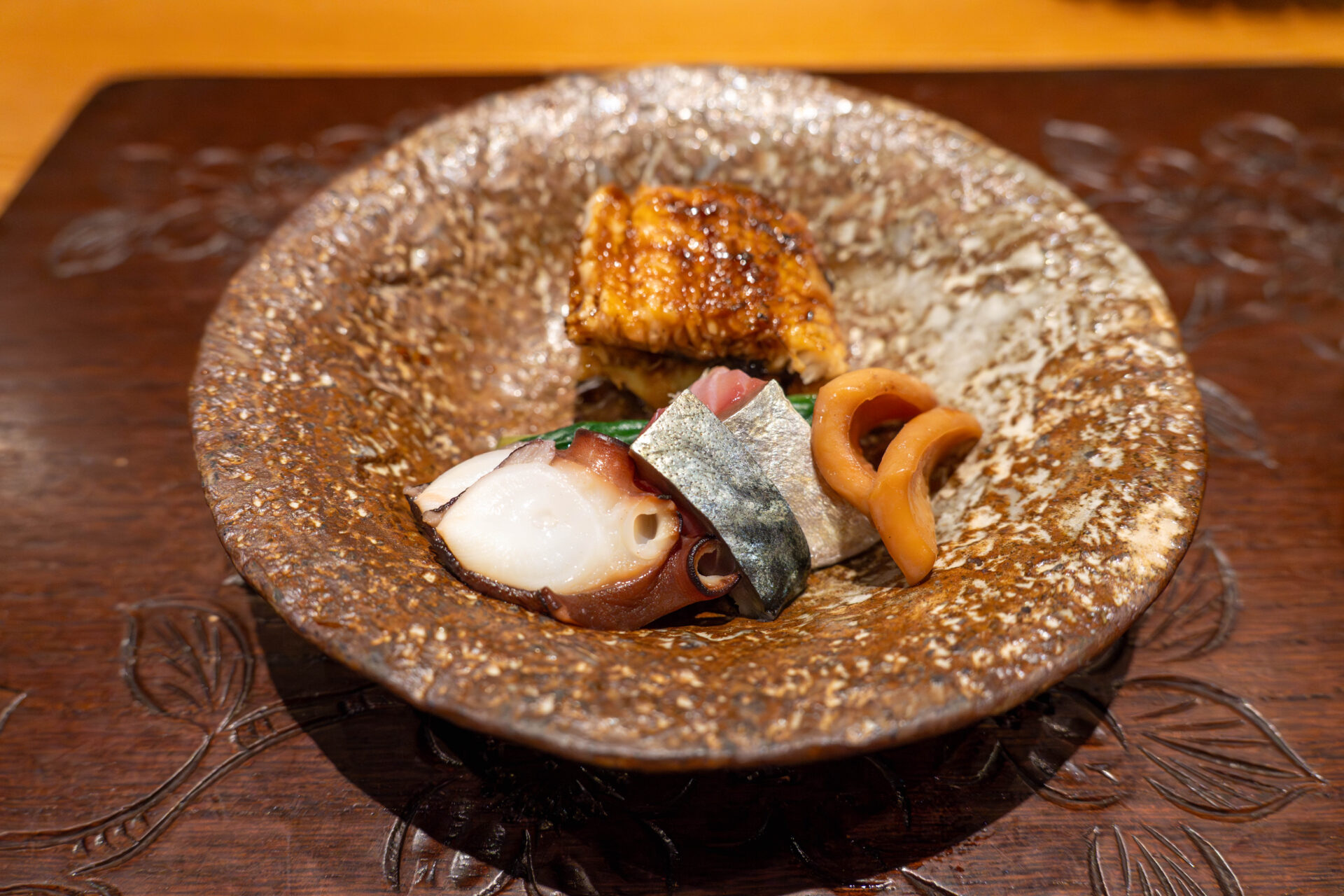
Aji Nigiri
Before the tempura begins, Takeuchi serves serious nigiri as well. Fatty aji is finely scored on the surface and topped with aromatics and ginger, then handed directly to you. The soft flesh and sweet fat loosen in the mouth while the condiments tighten the finish—craft worthy of a dedicated sushi-ya, priming you for the tempura course to come.
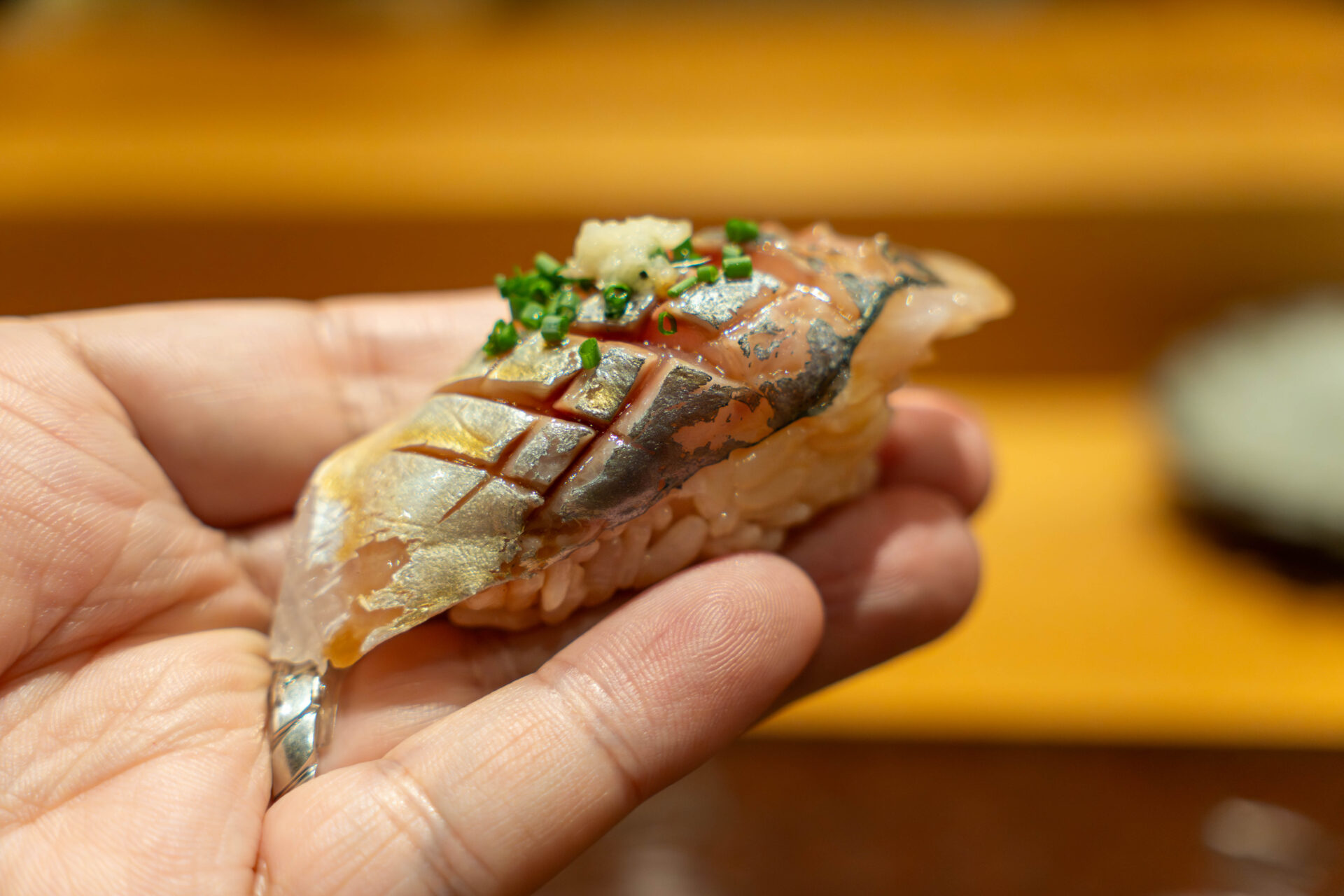
Negitoro Hand Roll
A hand roll with negitoro made from Aomori bluefin tuna as the core, topped generously with Aka-uni from Amakusa. The tuna’s sweet fat and the uni’s richness are wrapped in fragrant Ariake nori. With each bite, the seaweed’s aroma blooms and the ocean’s sweetness and umami spread as one indulgent mouthful.
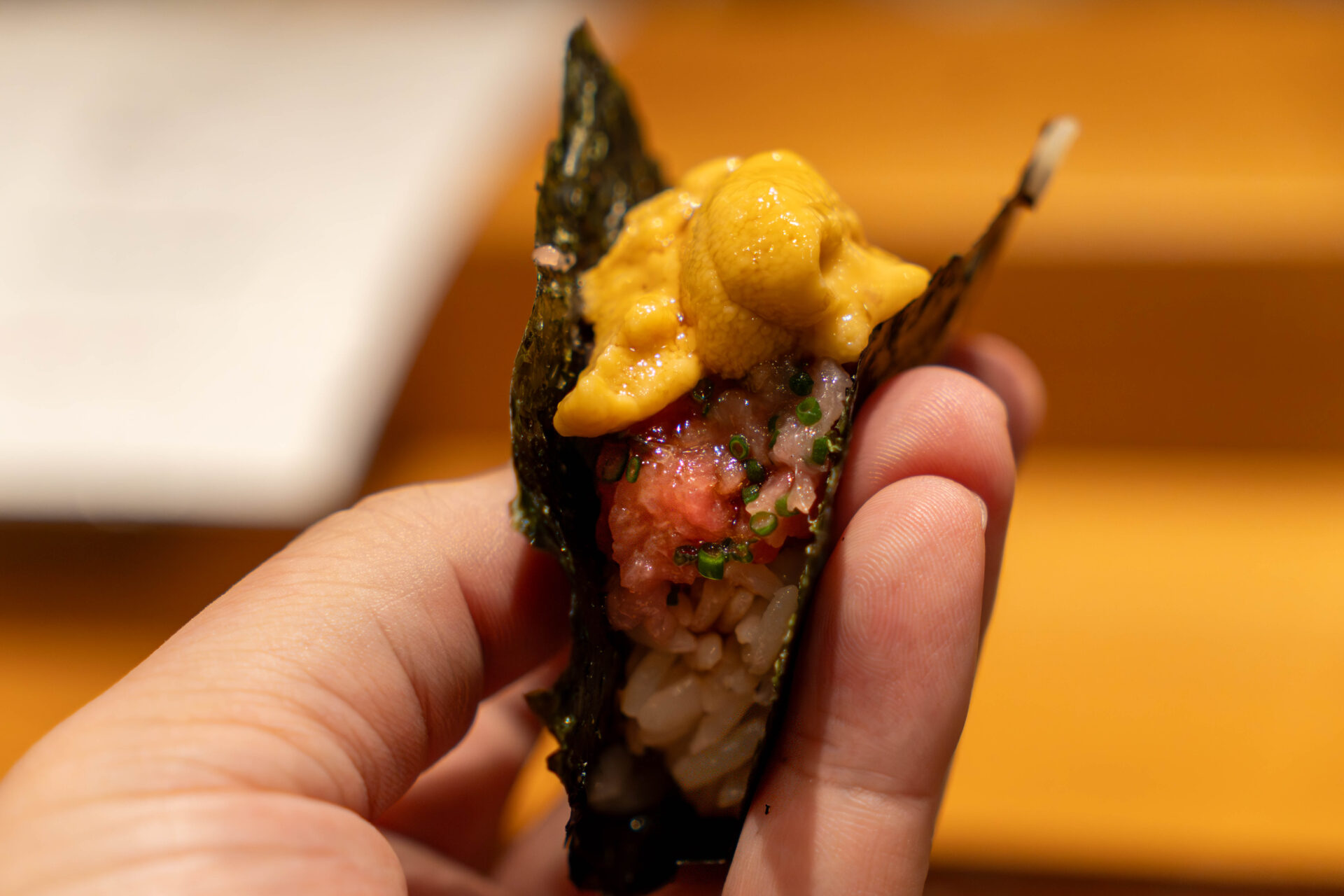
Chawanmushi
Steamed egg custard topped with shredded snow crab and Ariake nori. The crab’s sweetness melts into the delicate custard while the nori scattered on top adds aroma. Dashi and briny notes come together, gently carrying the course forward with comforting warmth.
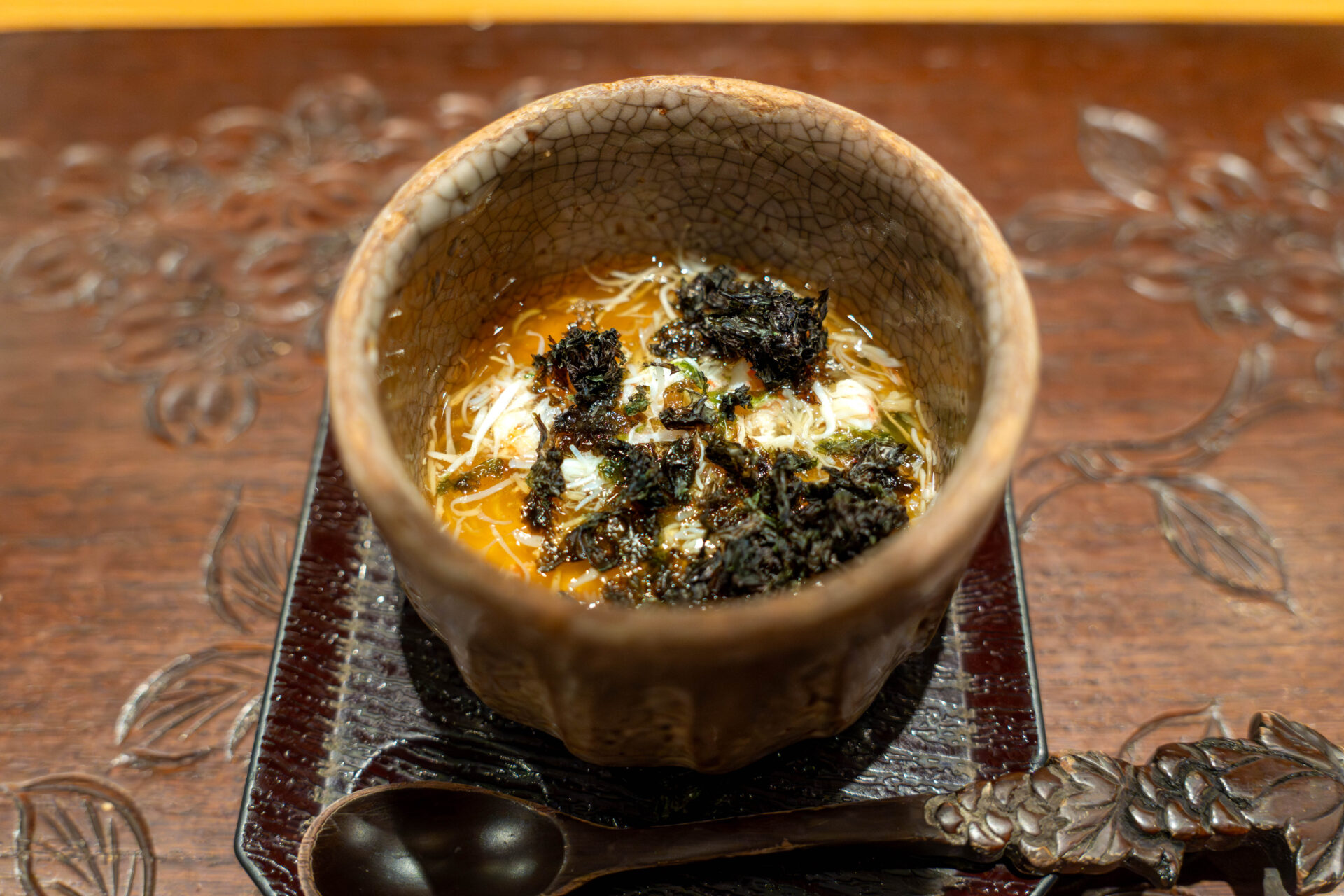
The Tempura Begins
When the chef starts to fillet the anago, that’s the cue for tempura.
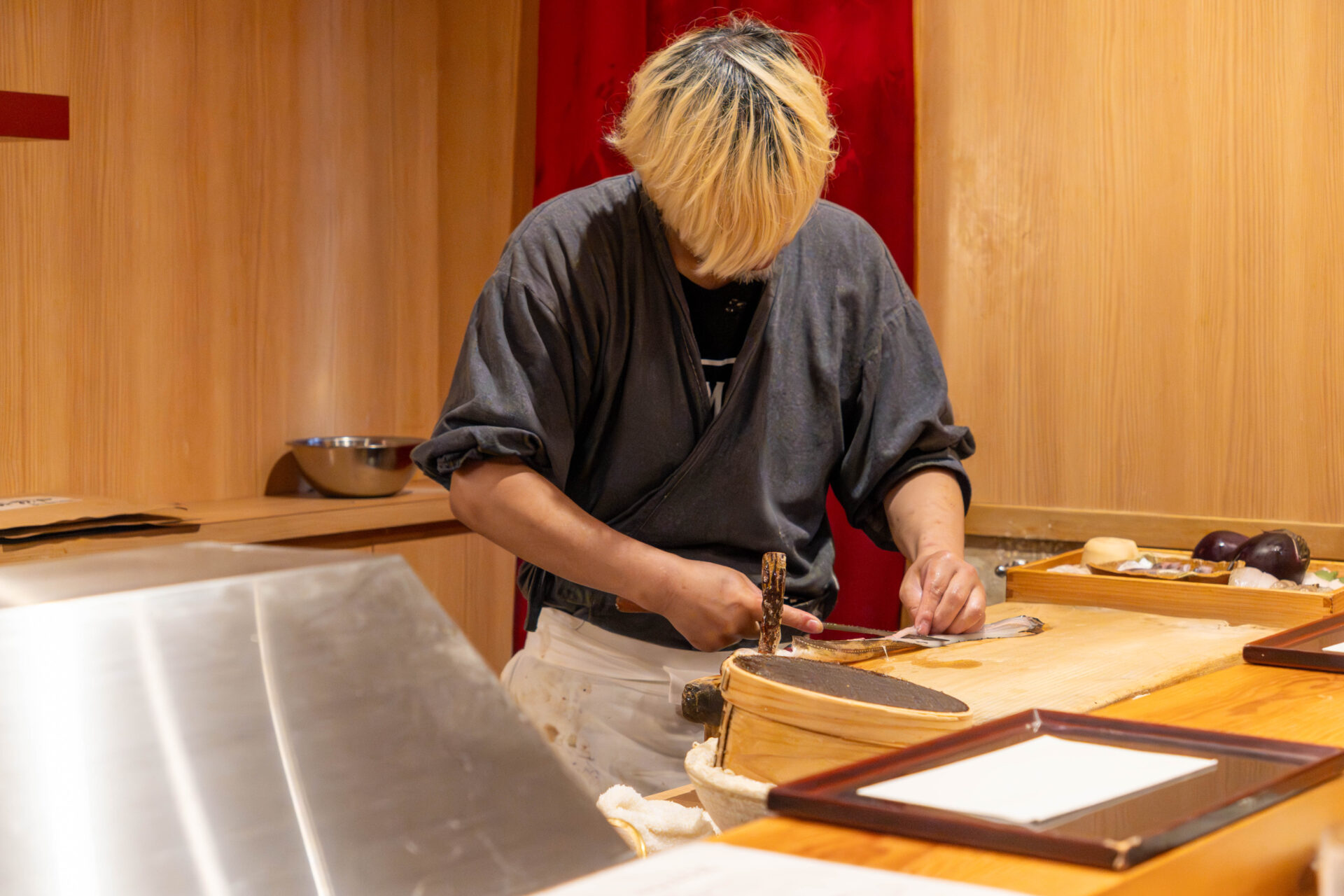
In front of you are quietly set dashi, salt, and shio-kōji. The clear dashi elevates the ingredients’ umami; the salt highlights flavors in a straightforward way; the shio-kōji adds mellow sweetness and depth, giving freshly fried pieces another dimension. Each condiment is chosen to best match the tempura that follows.
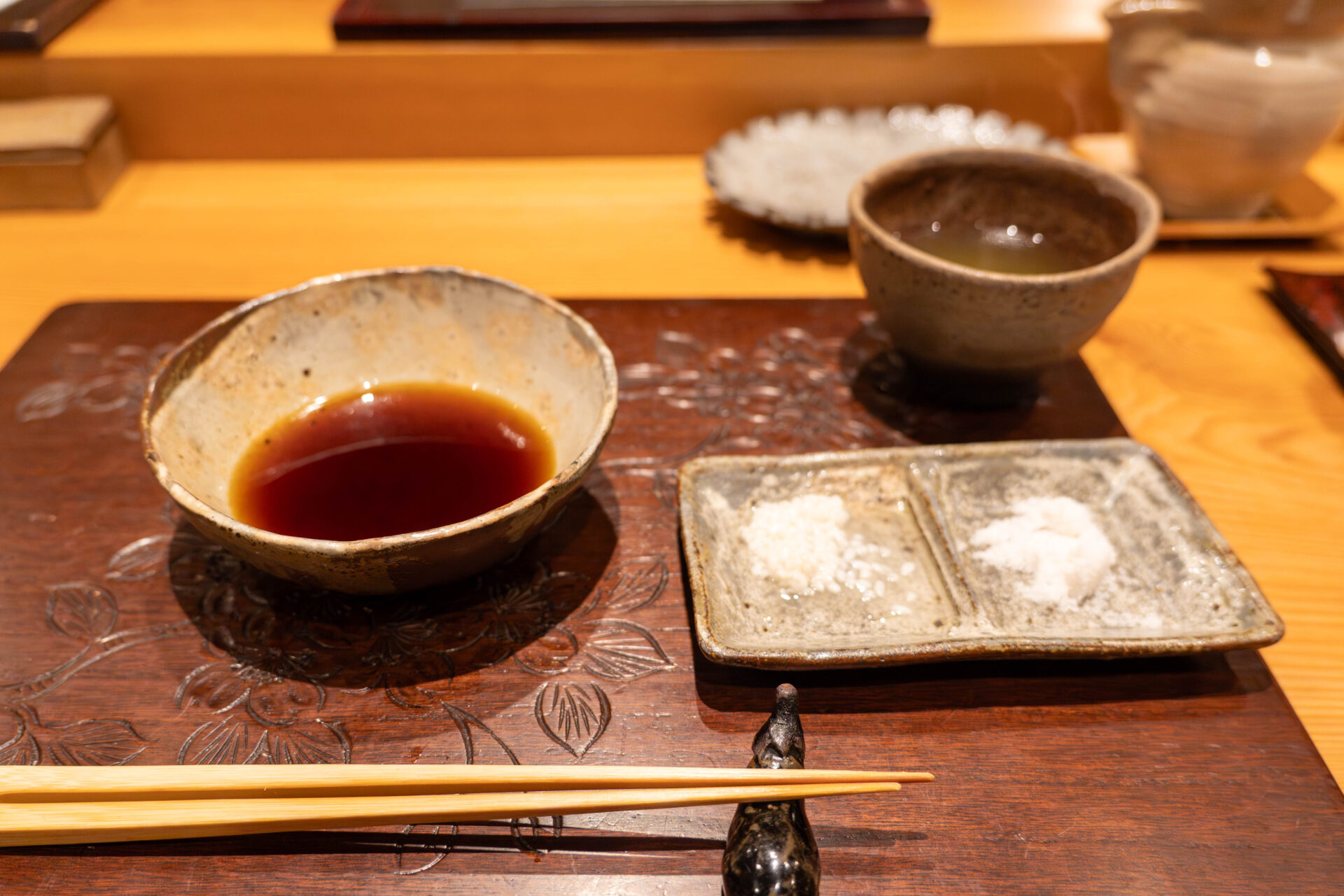
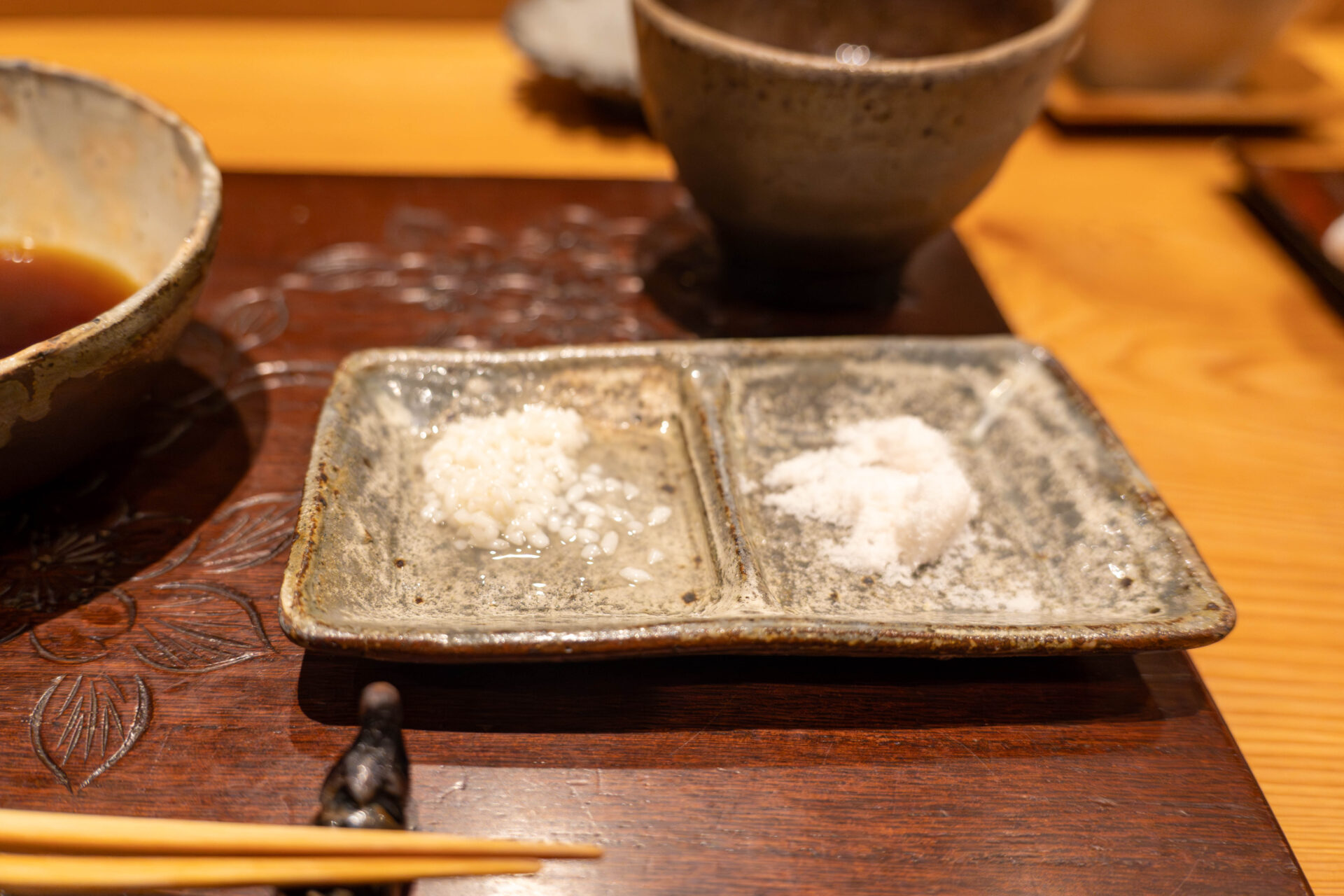
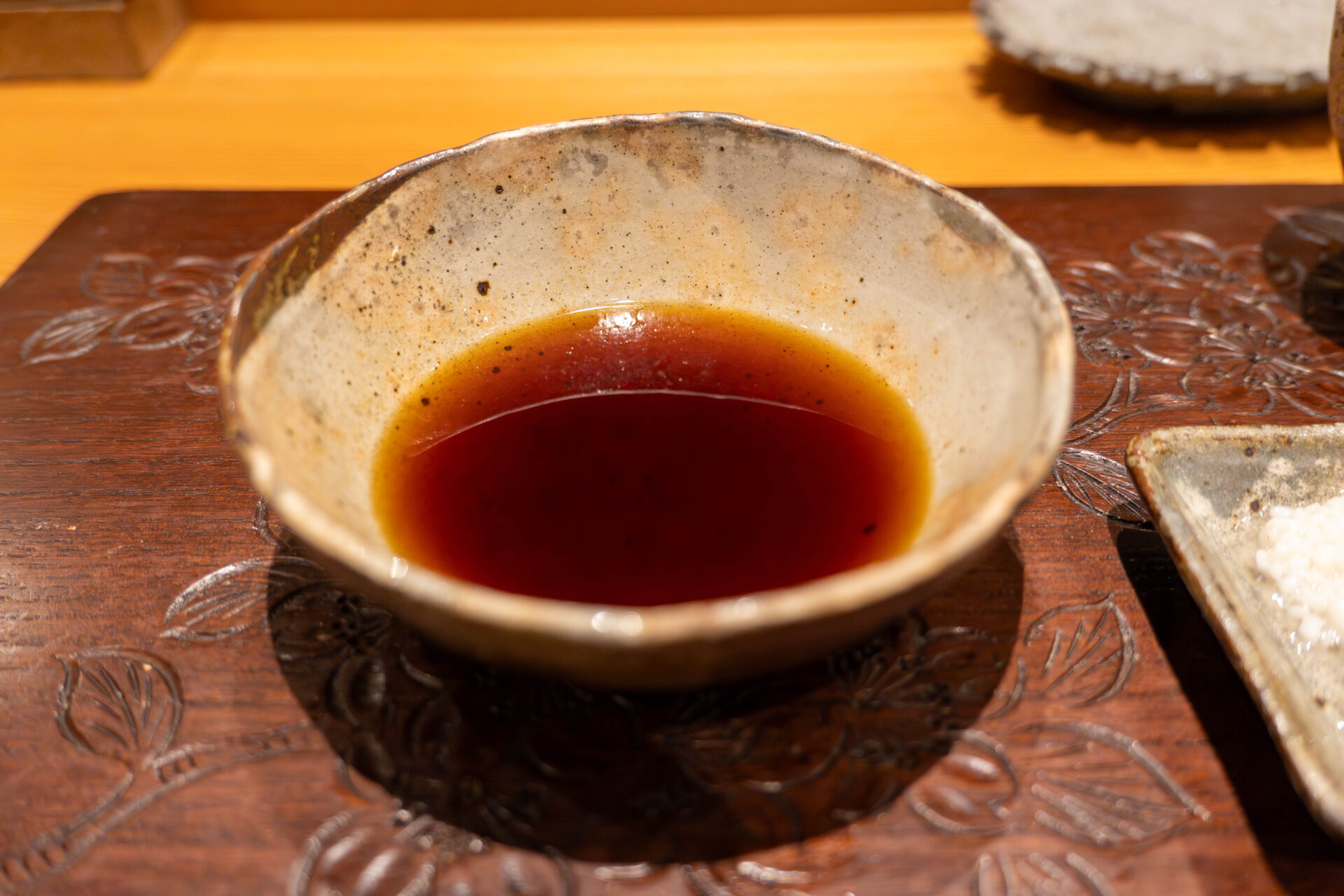
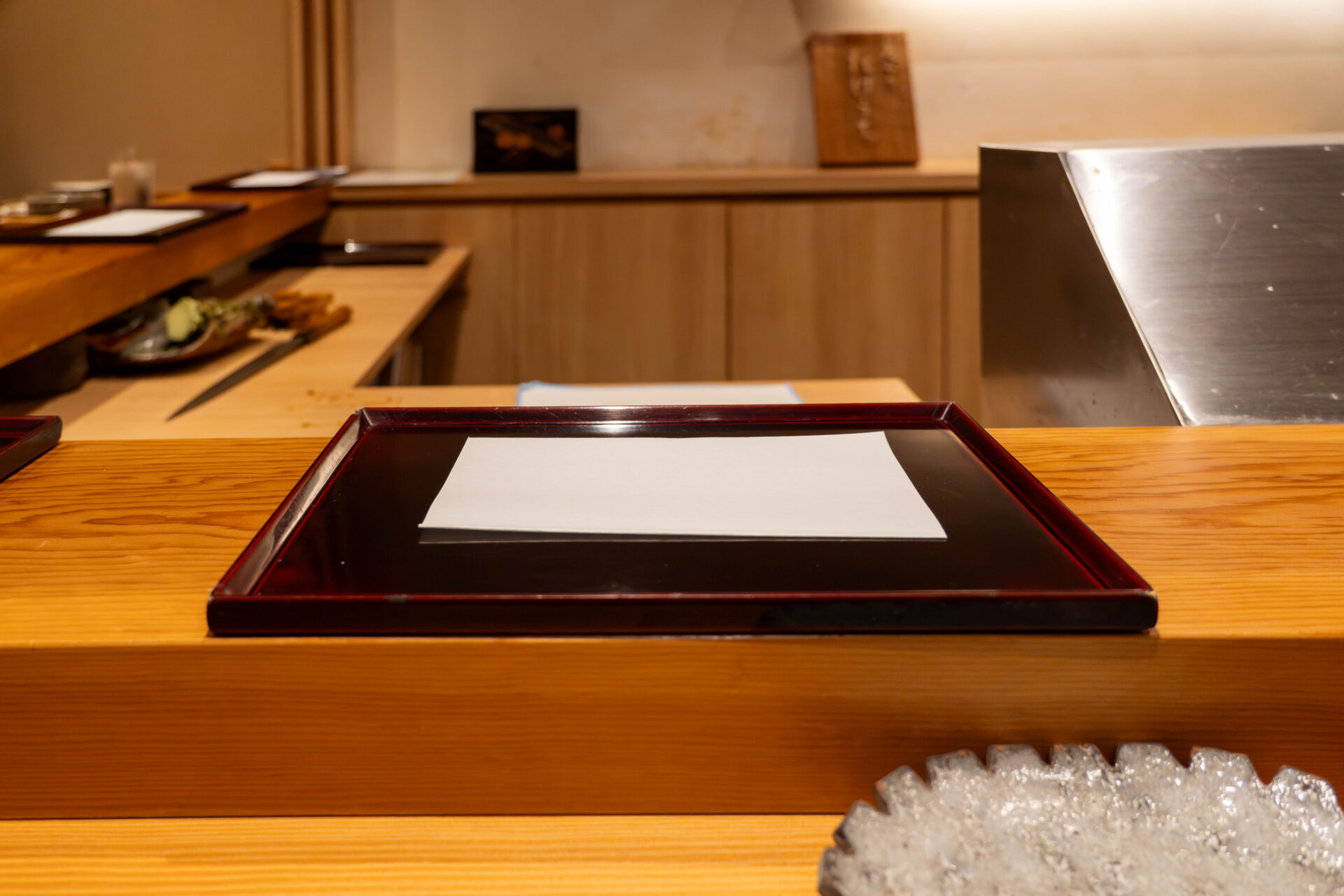
Morning-Caught Aji from Itoshima
The opener is morning-caught aji from Itoshima. A paper-thin, airy coating gives way to fluffy flesh. The bluefish aroma and umami of aji are gently wrapped by the toasty notes of the frying oil—an early course that raises expectations from the first bite.
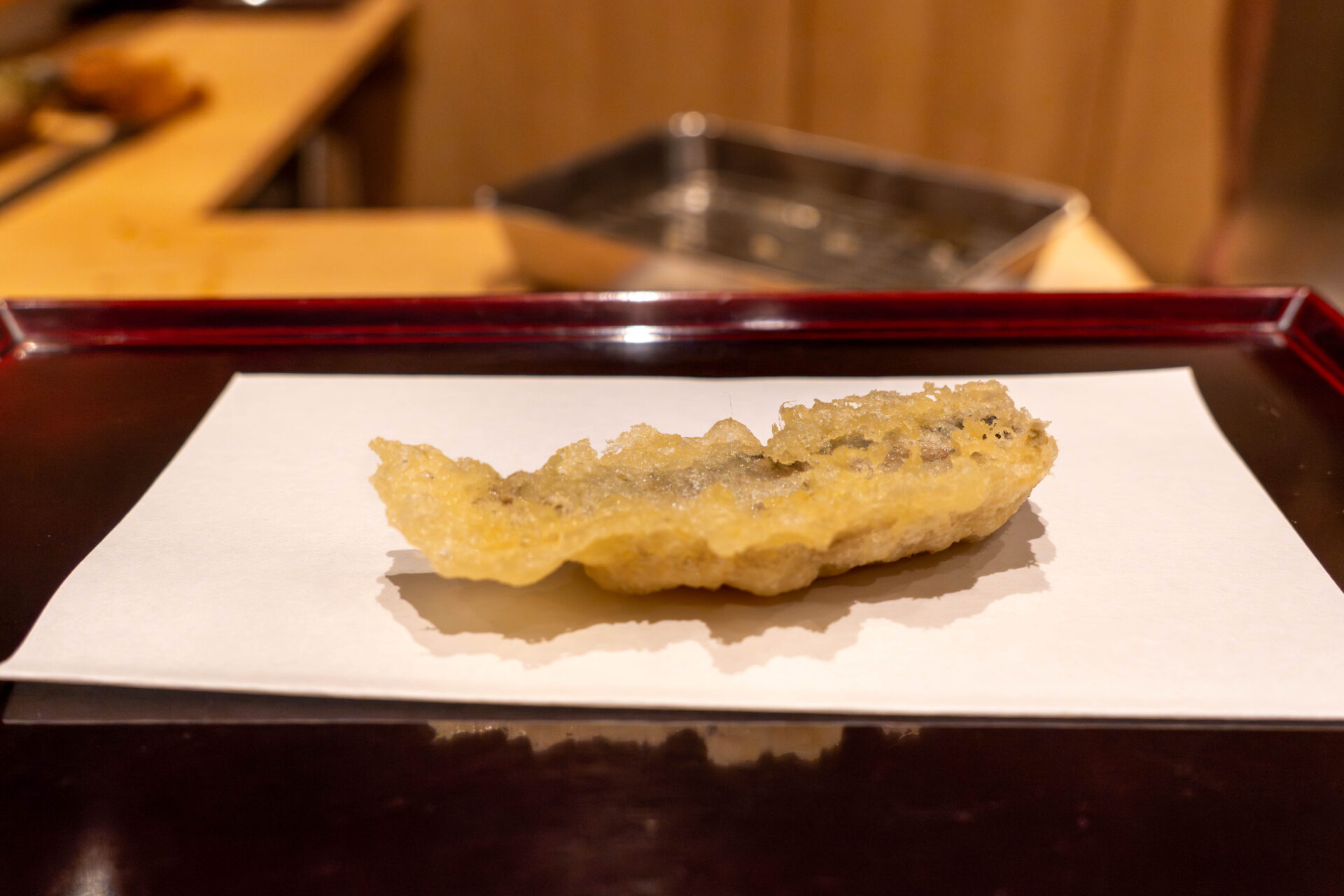
Kuruma-ebi Head
Next is the head of kuruma-ebi (Japanese tiger prawn). Fried shell-on at high heat, it concentrates aroma and sweetness. The initial crunch yields to rich tomalley flavor—an aromatic bite that captures the shrimp’s essence.
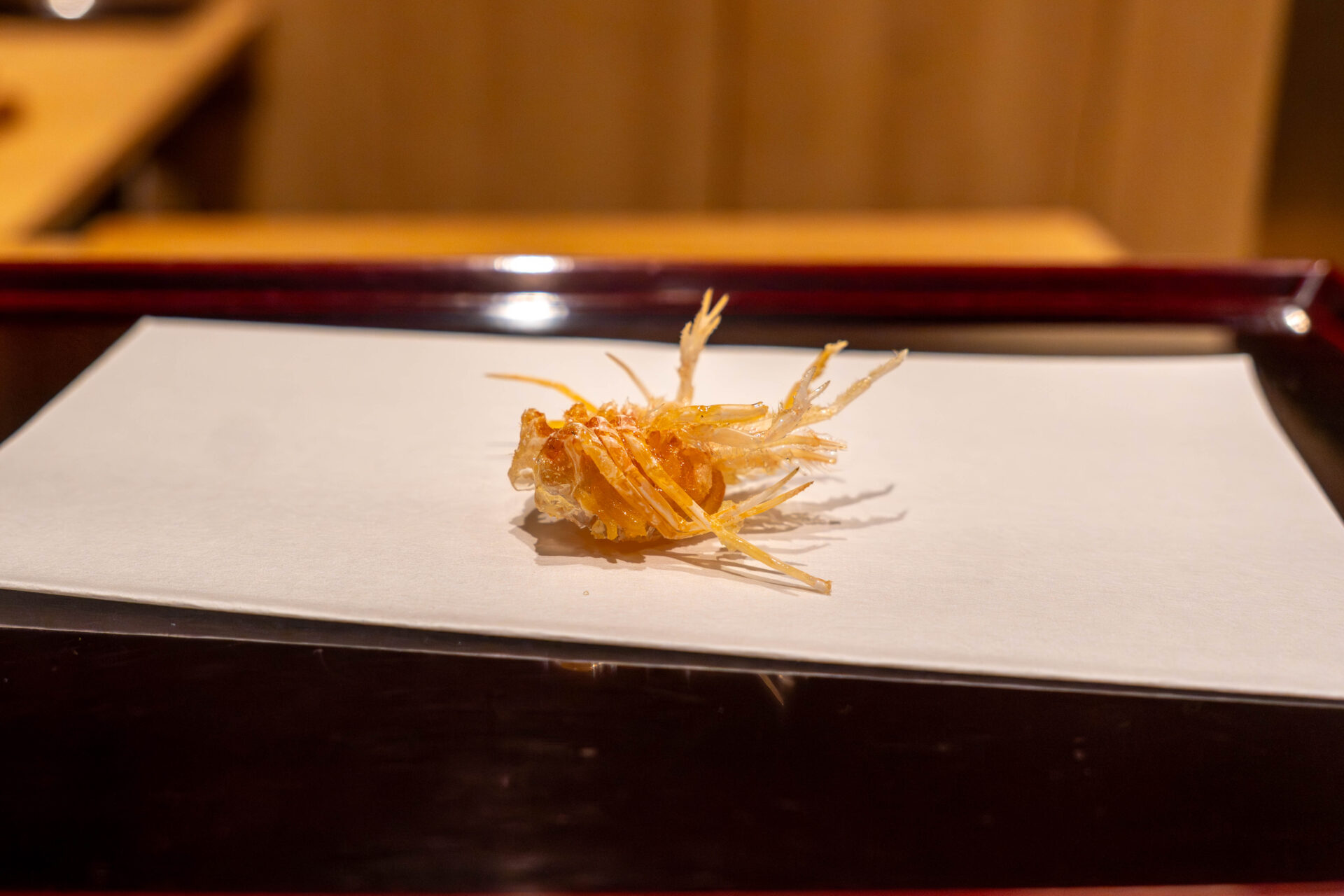
Kuruma-ebi Body
A generously sized kuruma-ebi tail. The batter is thin; bite in and it pops with a springy snap, releasing a delicate sweetness. A quick, high-temperature fry leaves the flesh translucent yet plump so you can savor the shrimp’s pure flavor.
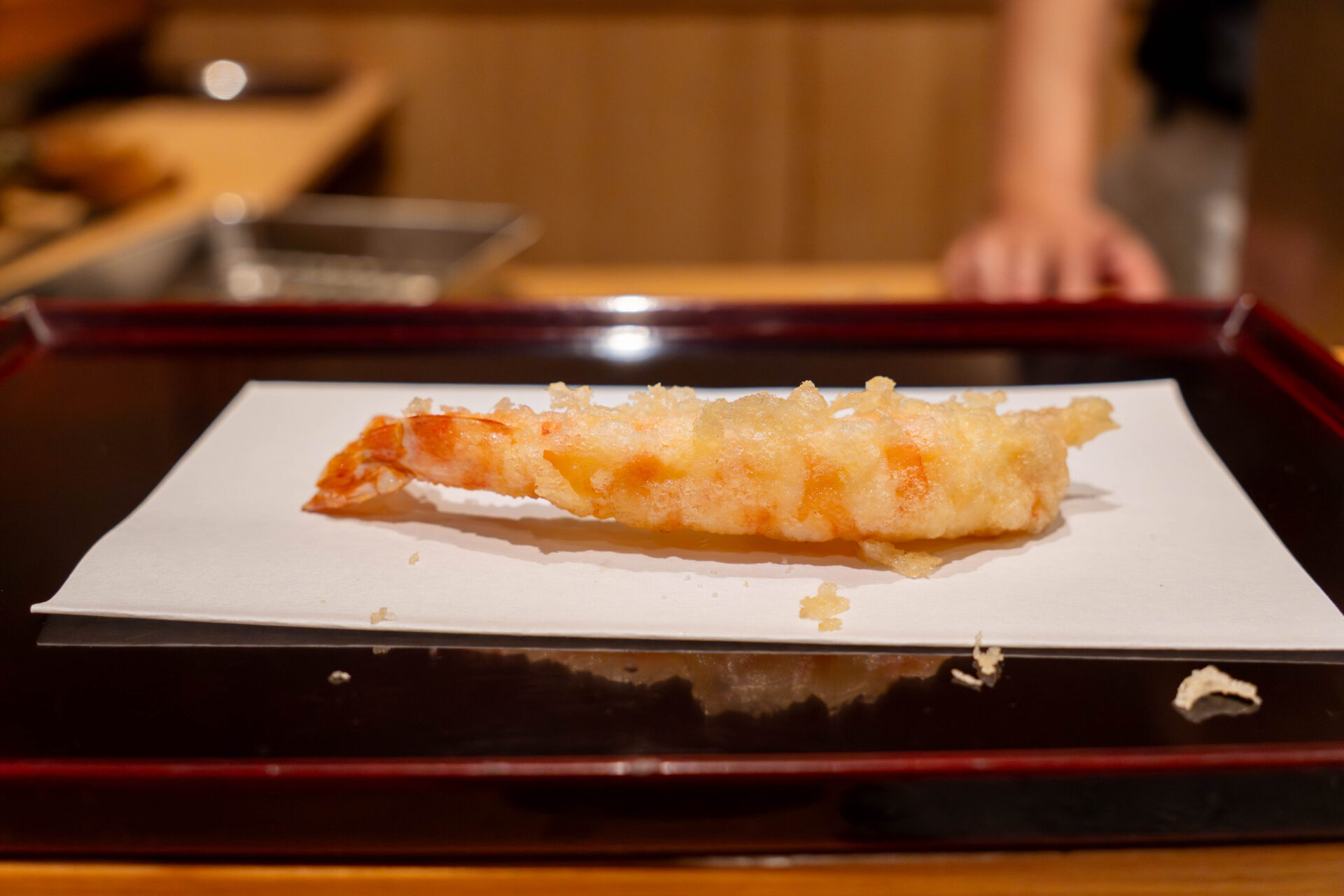
Shiraishi Lotus Root, Saga
Light, crisp batter encases a moist, slightly sticky interior. With each chew, the lotus root’s gentle sweetness spreads—a humble yet deeply satisfying flavor.
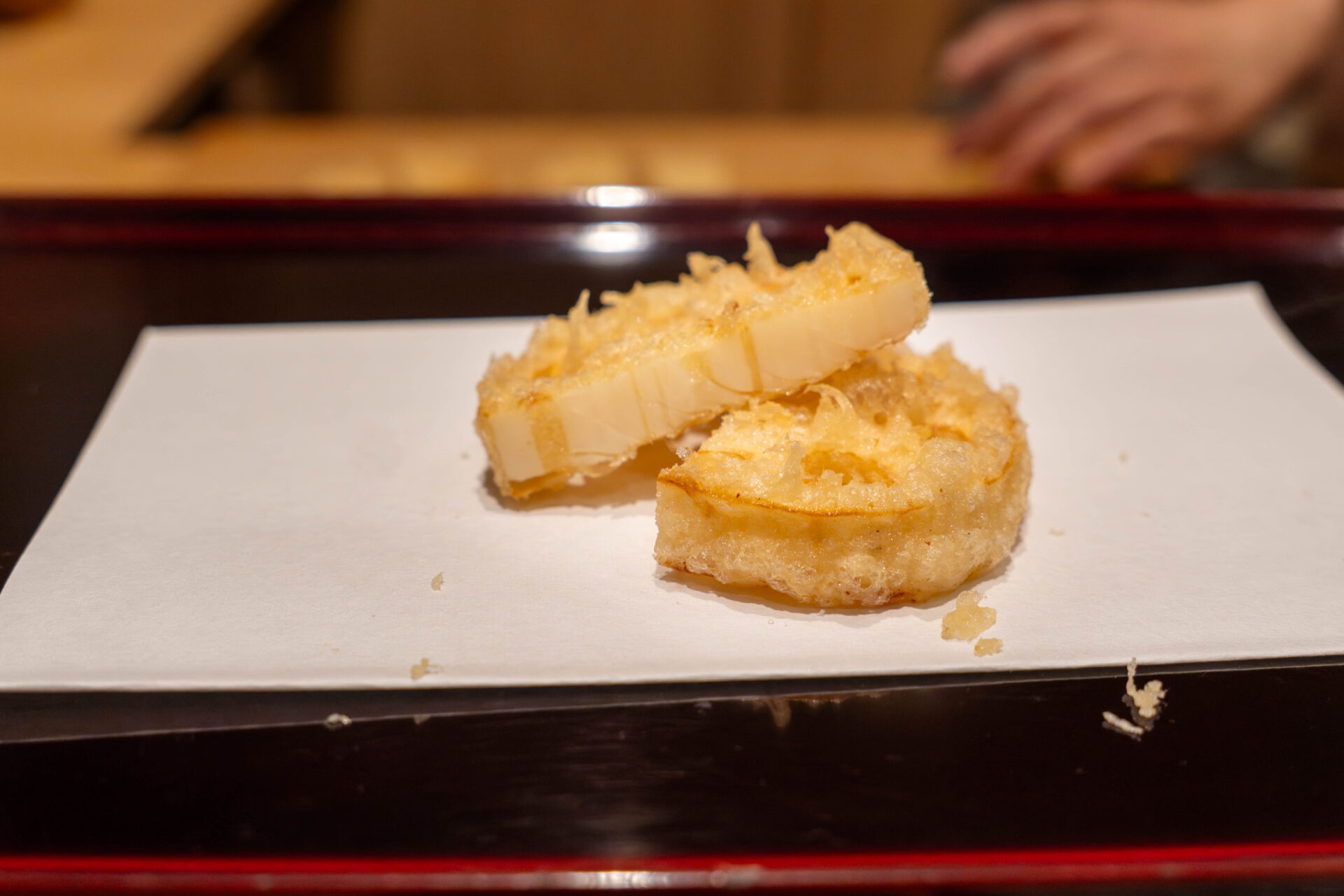
Hamaguri from Kokonoe, Oita
Inside the coating sits a plump clam; bite in and the springy texture releases concentrated juices. Briny aroma and sweetness fill the mouth—simple yet unforgettable.
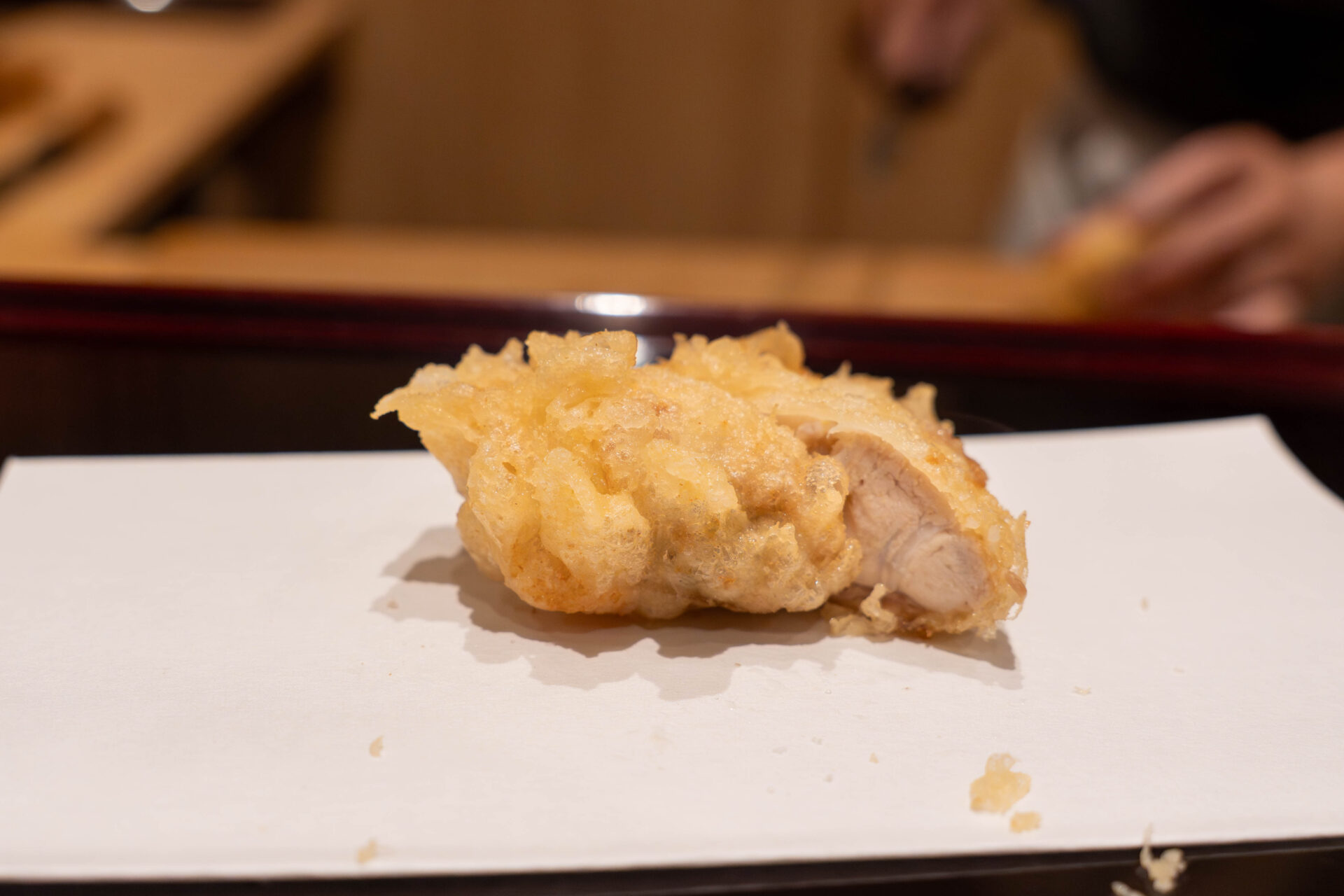
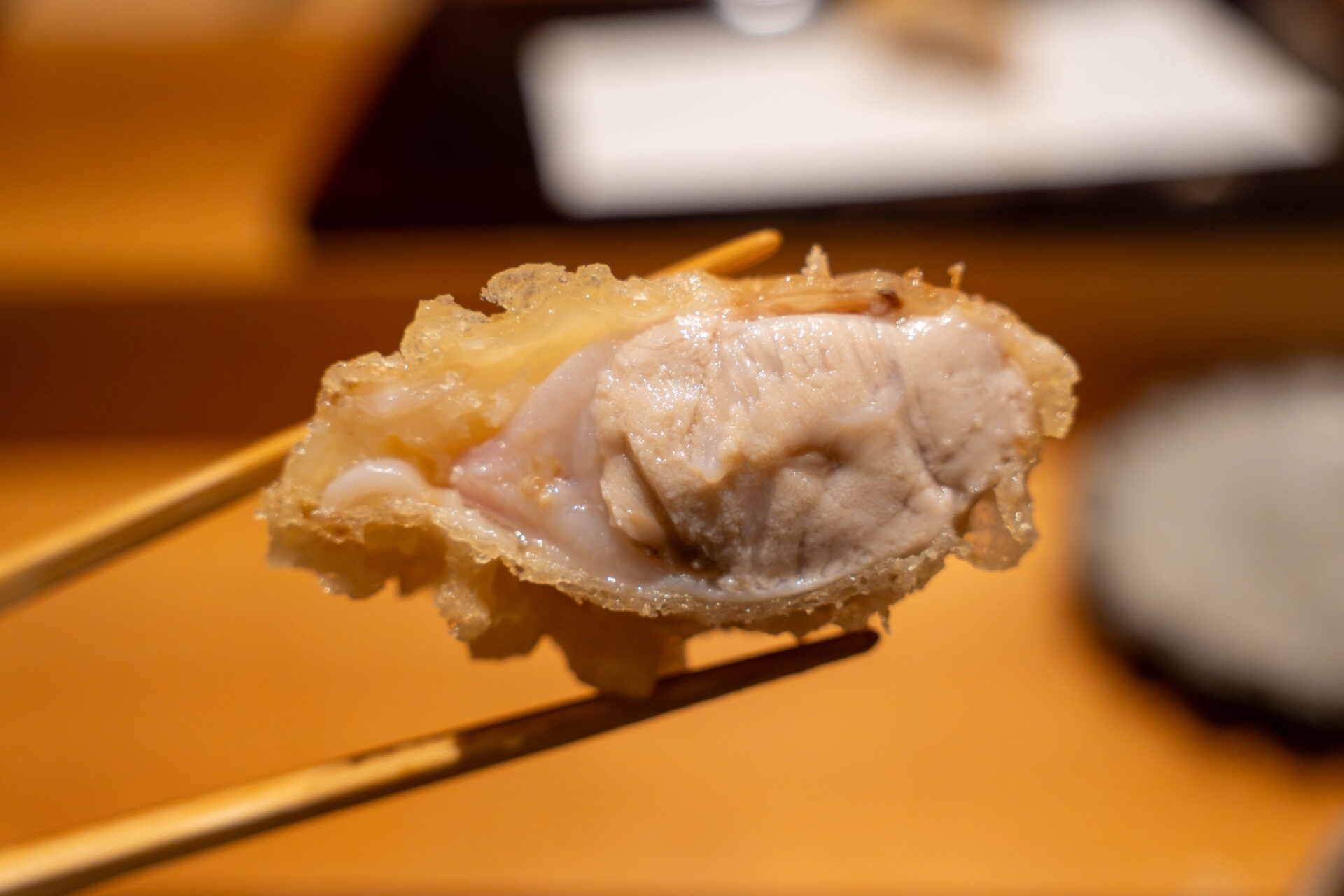
Palate Cleanser: Mizuna & Whelk
Crisp mizuna, aromatic rock nori, and tender simmered whelk (tsubugai) come together to reset the palate mid-course.
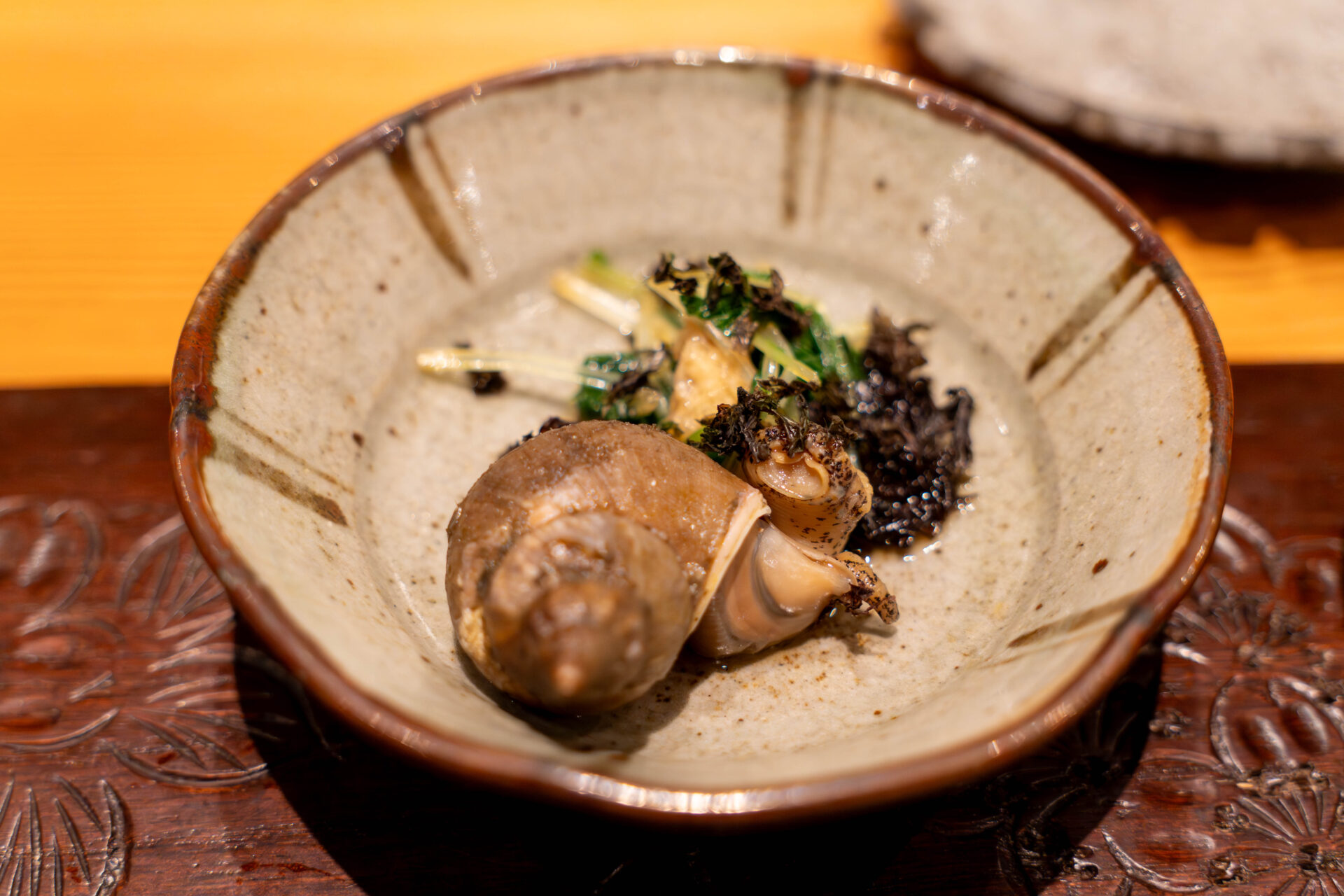
Whiting from Genkai
A refined piece with a thin, airy crust and flaky, plump white flesh that gently falls apart.
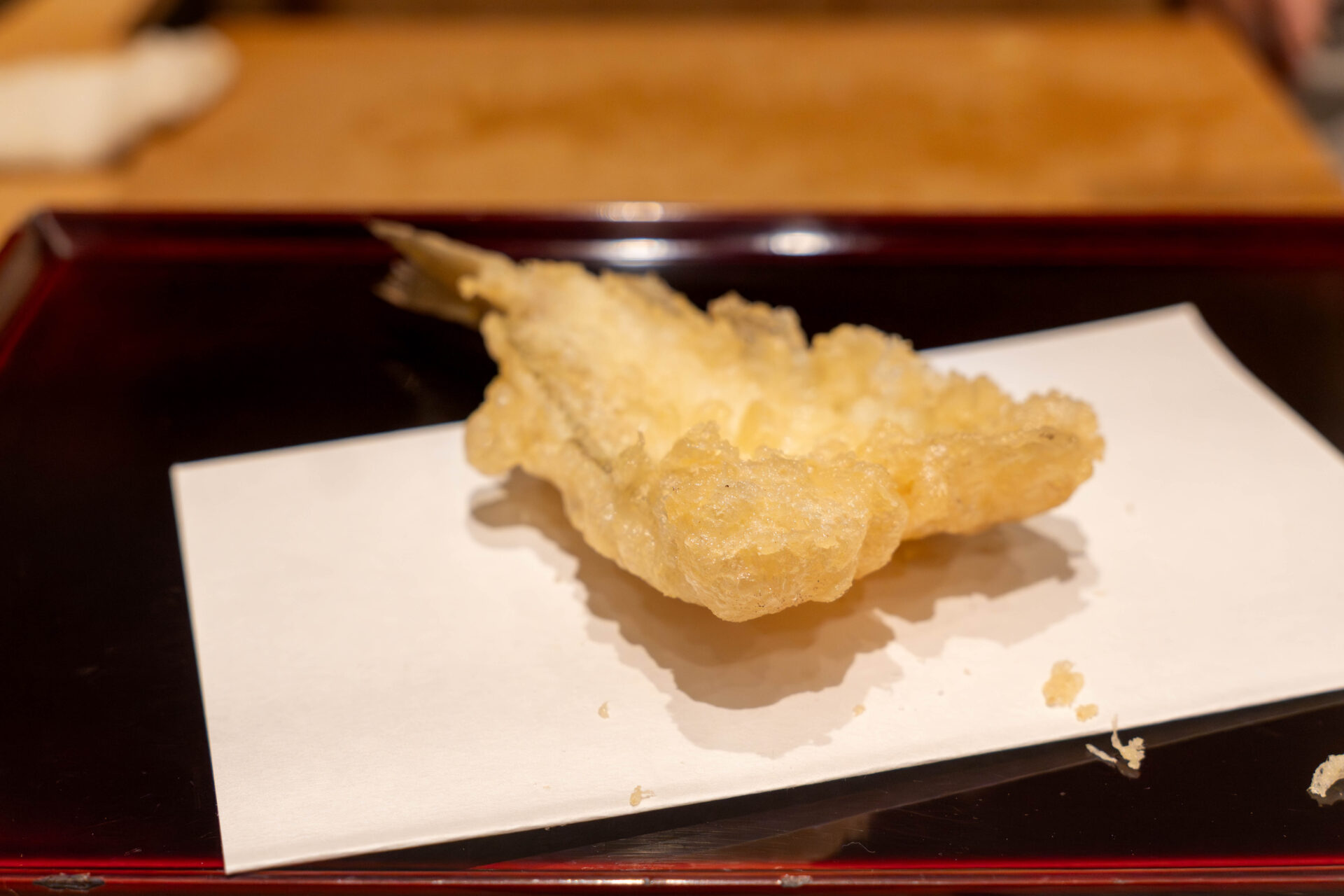
Kumamoto “Melting Stir-Fried Eggplant”
Inside the coating is eggplant that’s been stir-fried to draw out sweetness and depth, sealed in while meltingly soft. Bite in and hot juices and umami flood out—one of the most memorable vegetable tempura preparations.
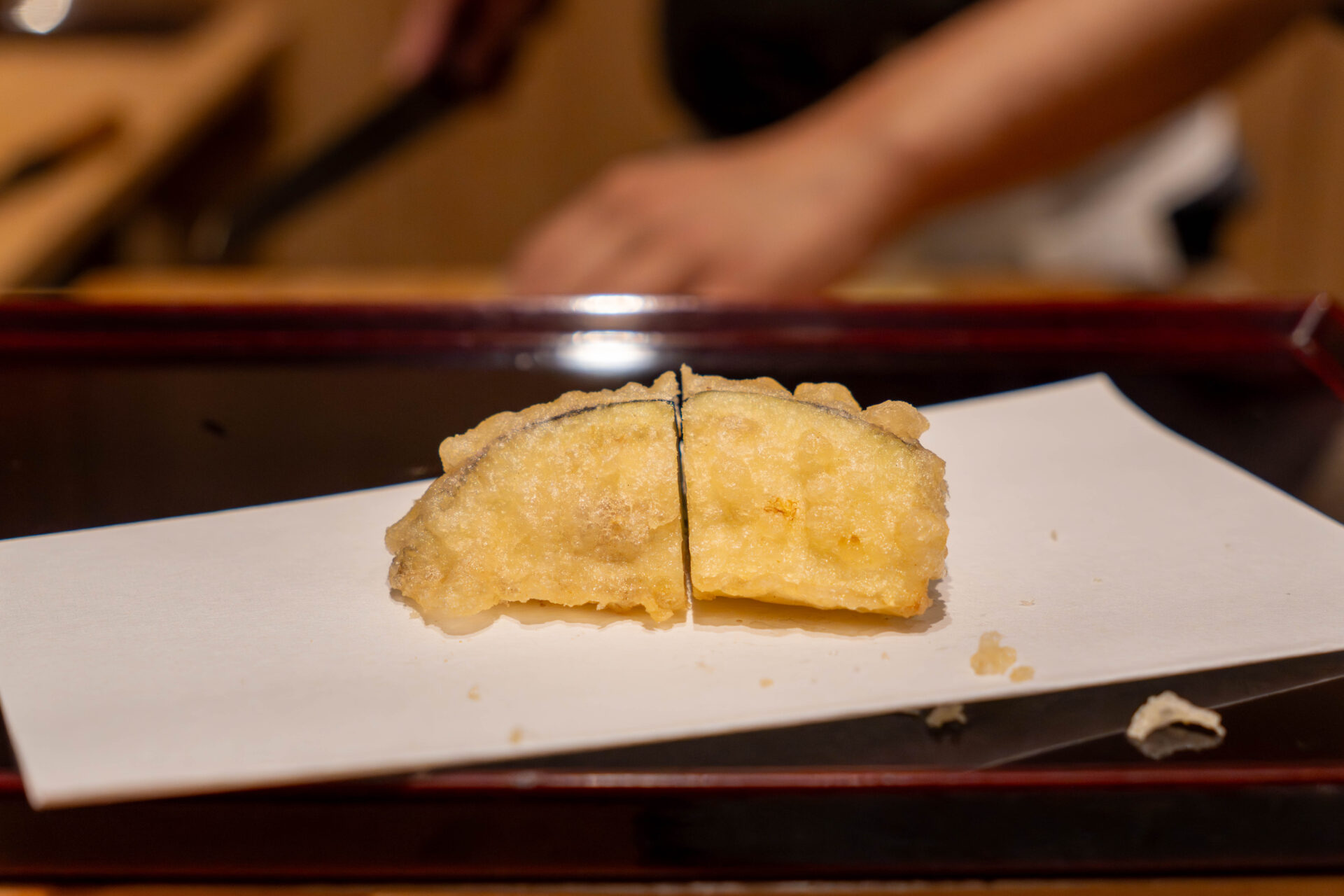
Butterfish Wrapped in Ōba
Delicate managatsuo (butterfish) wrapped in aromatic shiso (ōba) and fried to a fragrant finish. The fluffy flesh and refreshing herb are in perfect balance.
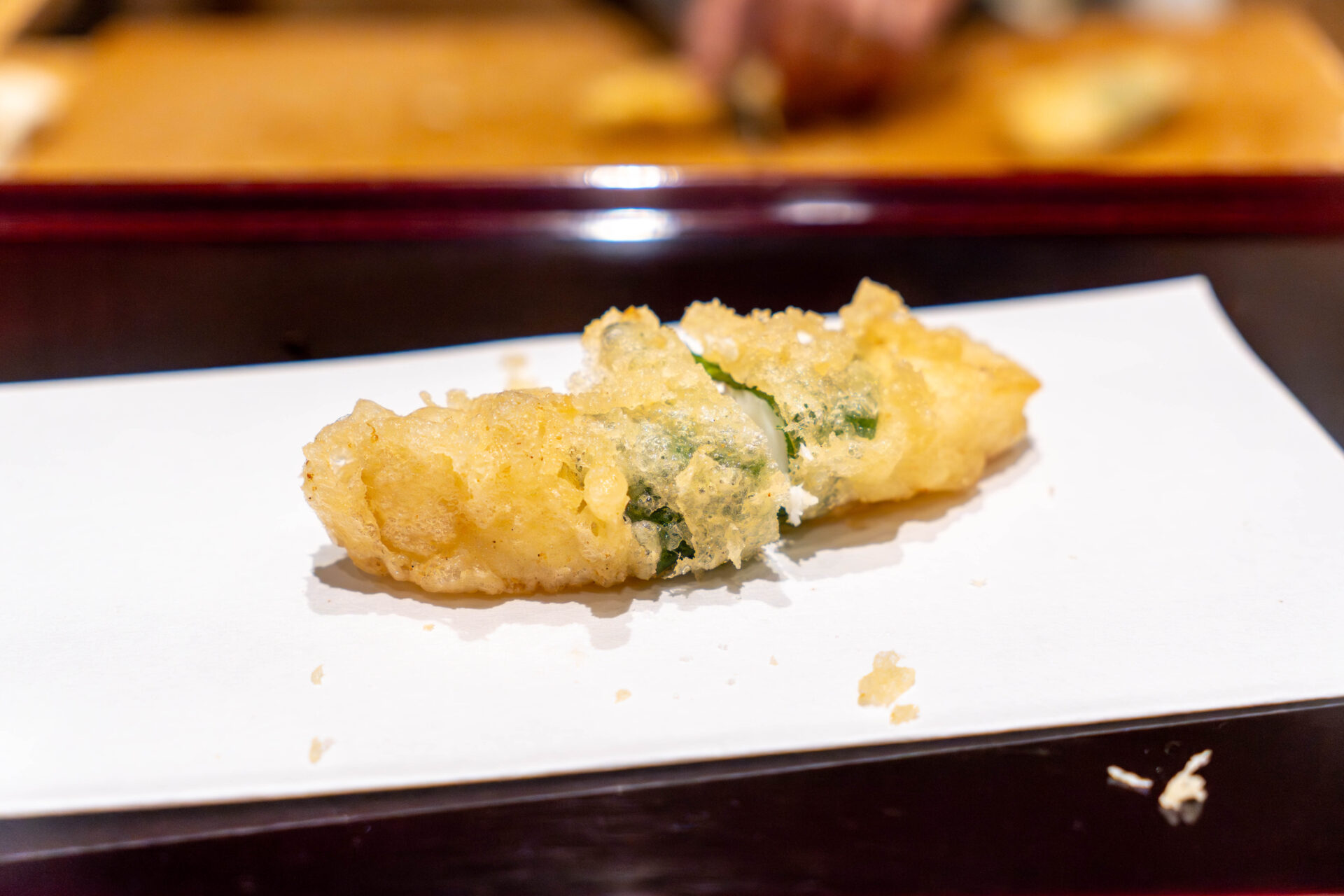
Local Asparagus
Crisp, fresh asparagus from Nakagawa, done as tempura. A satisfying snap and an aromatic tip.
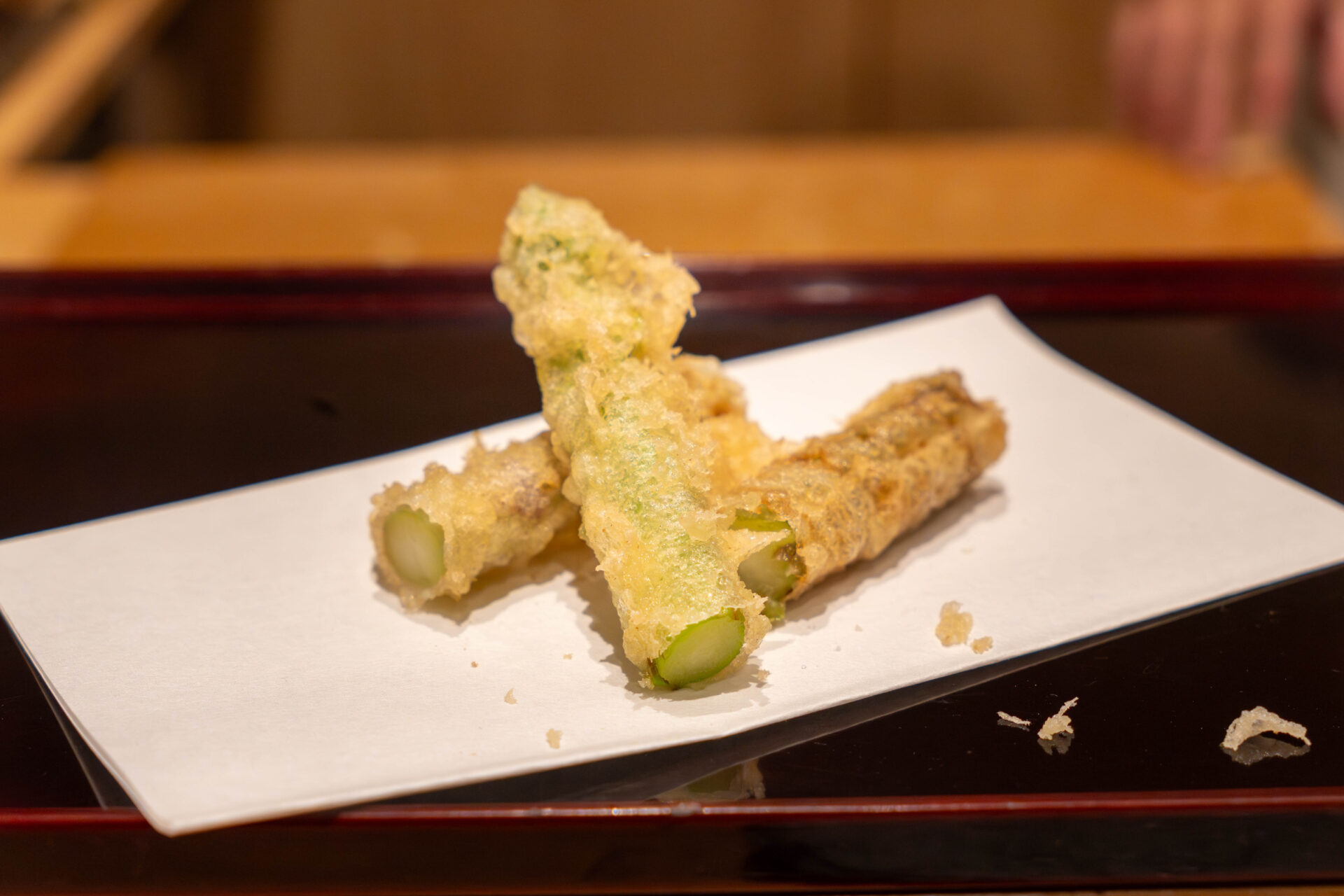
Tsushima Anago
The tempura finale is plump, freshly fried anago from Tsushima—crisp outside, fluffy within.
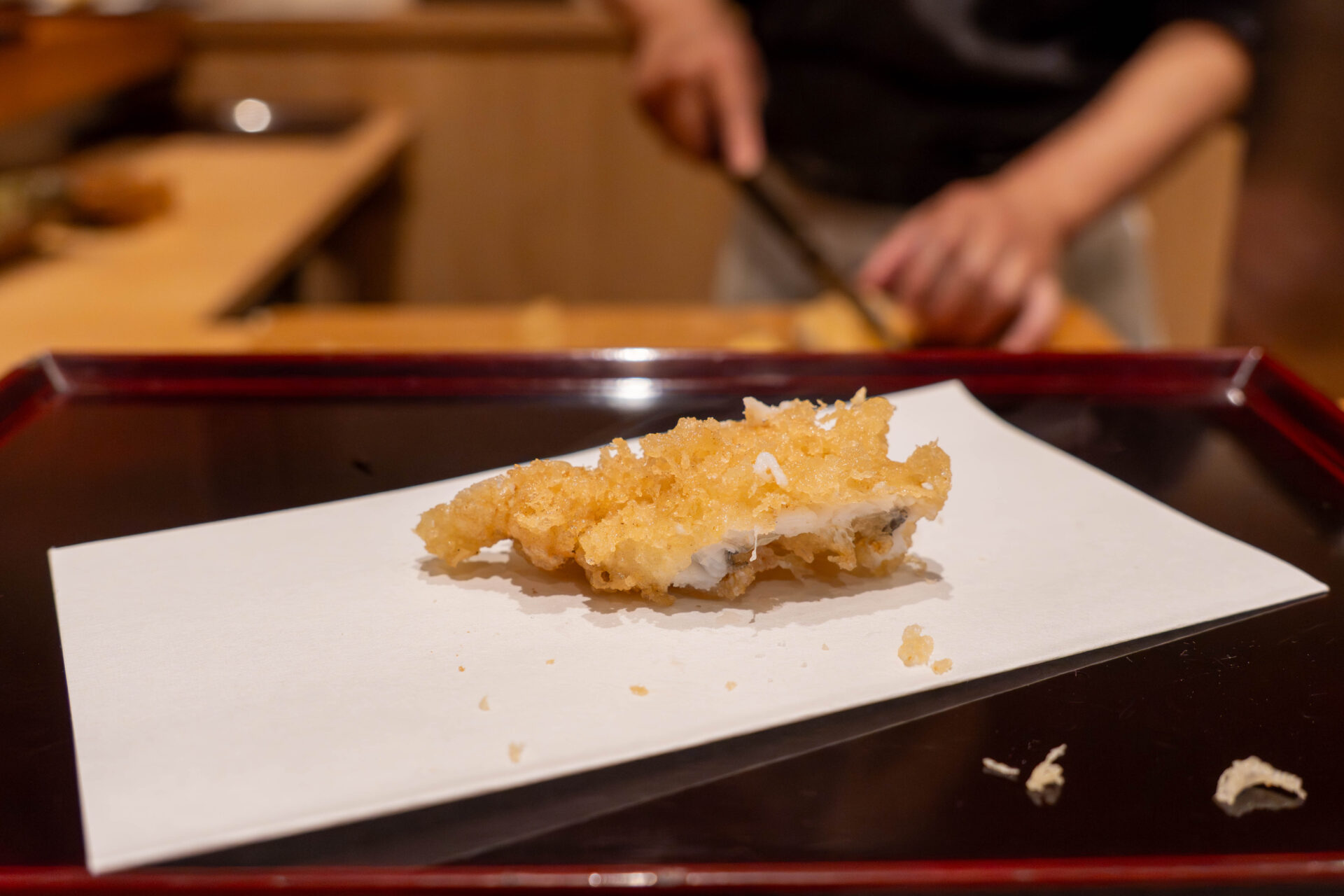
Matsutake & Managatsuo Takikomi Gohan
To close, fragrant early-season matsutake and umami-rich managatsuo are cooked together in rice.
Enjoy the first bowl as is; for the second, pour on dashi and savor it as chazuke for a different expression.

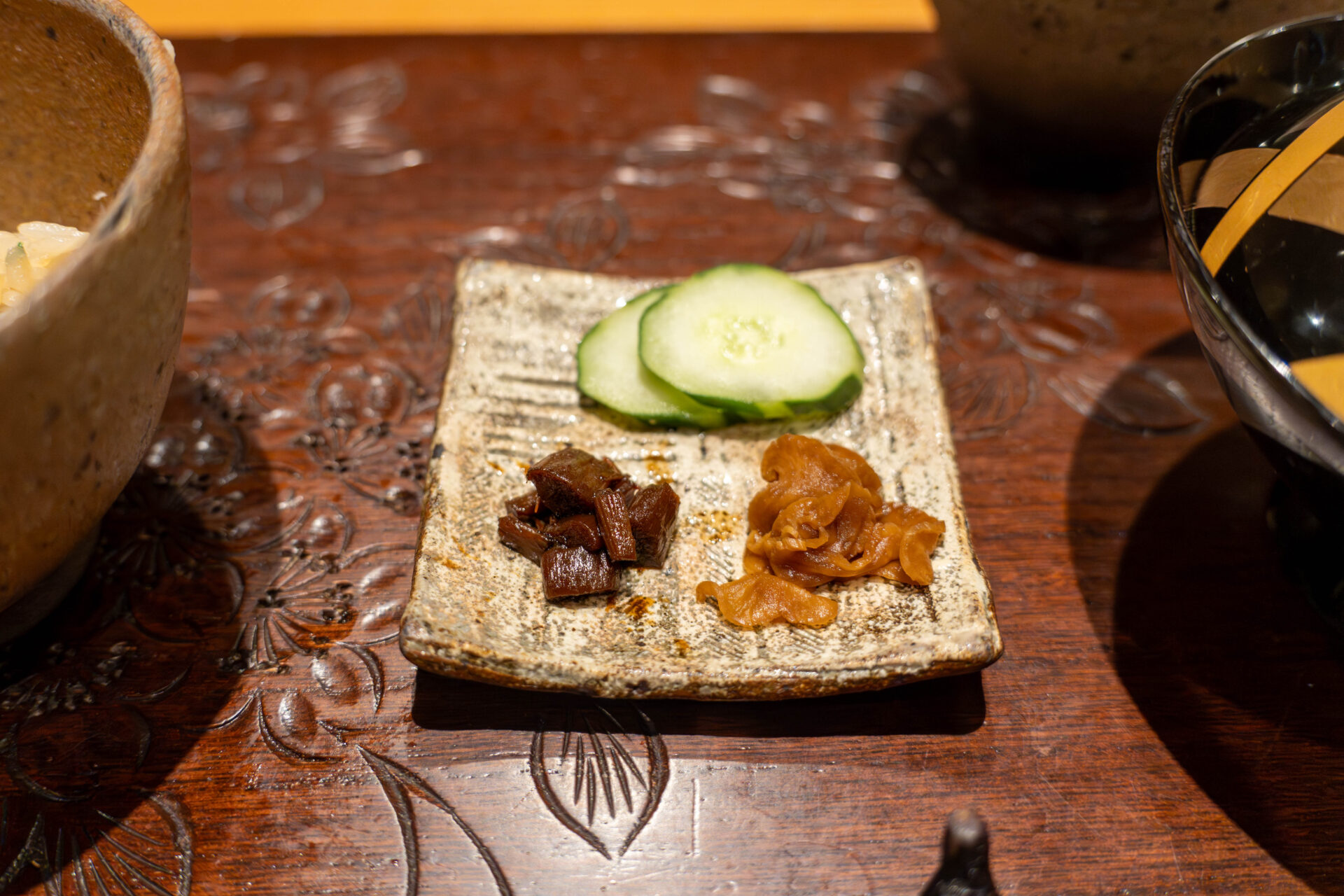
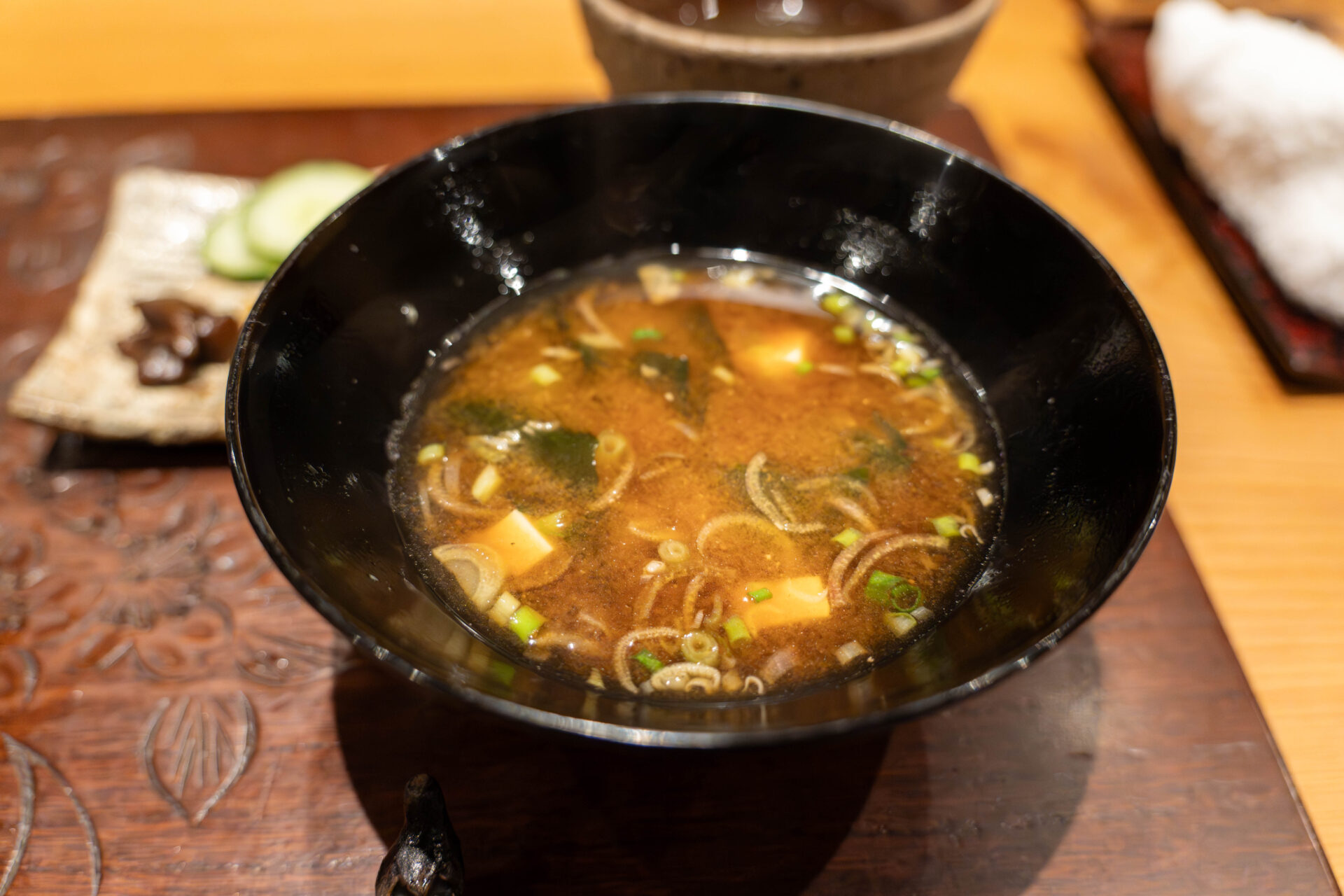

Dessert & Finale
Seasonal Fruit
A colorful plate of Shine Muscat grapes, juicy pear, and richly sweet mango.
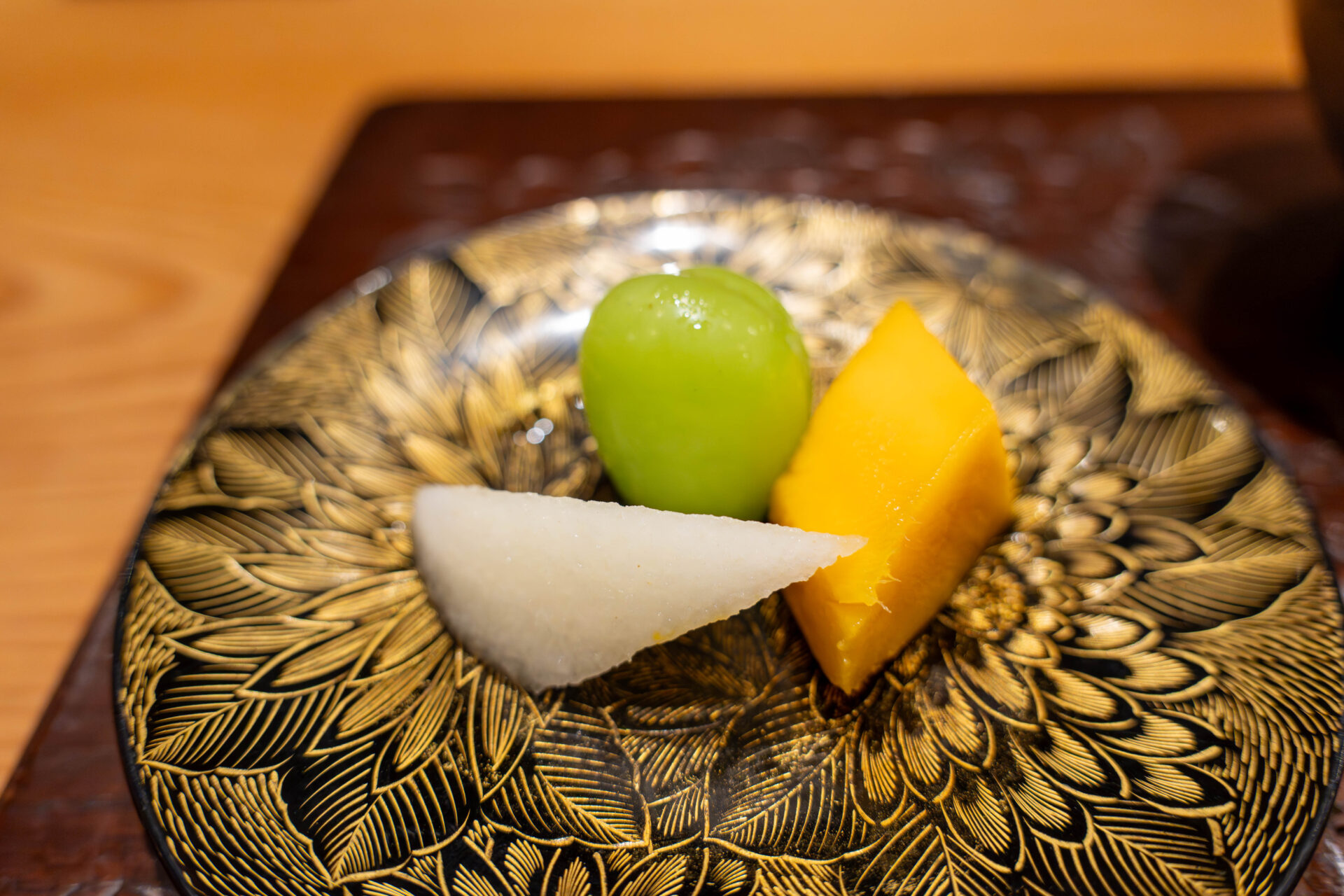
Summary & Impressions
From the early small plates and sashimi through the palate refresher, the flow delivers ample satisfaction even before the tempura begins. While showcasing seasonal ingredients, each dish has its own personality in seasoning and plating, fulfilling its role as a prologue to the meal.
Once the tempura starts, you feel the accumulation of experience and ingenuity that the chef has cultivated through self-study. The lightness of the coating, the control of oil temperature, the respectful distance to the ingredients—each choice avoids formula yet follows a clear internal logic. Rather than resort to gimmicks, he applies thoughtful subtraction to maximize the ingredients, while gentle variations keep interest throughout.
From the rice and soup at the end to the fruit, the closing sequence is quiet and deliberate, like sketching the lingering aftertaste with a fine brush. Overall, it makes you want to return in different seasons to experience changing ingredients and expressions. It’s a place where repeat visits reveal the charm of evolution and accumulation.
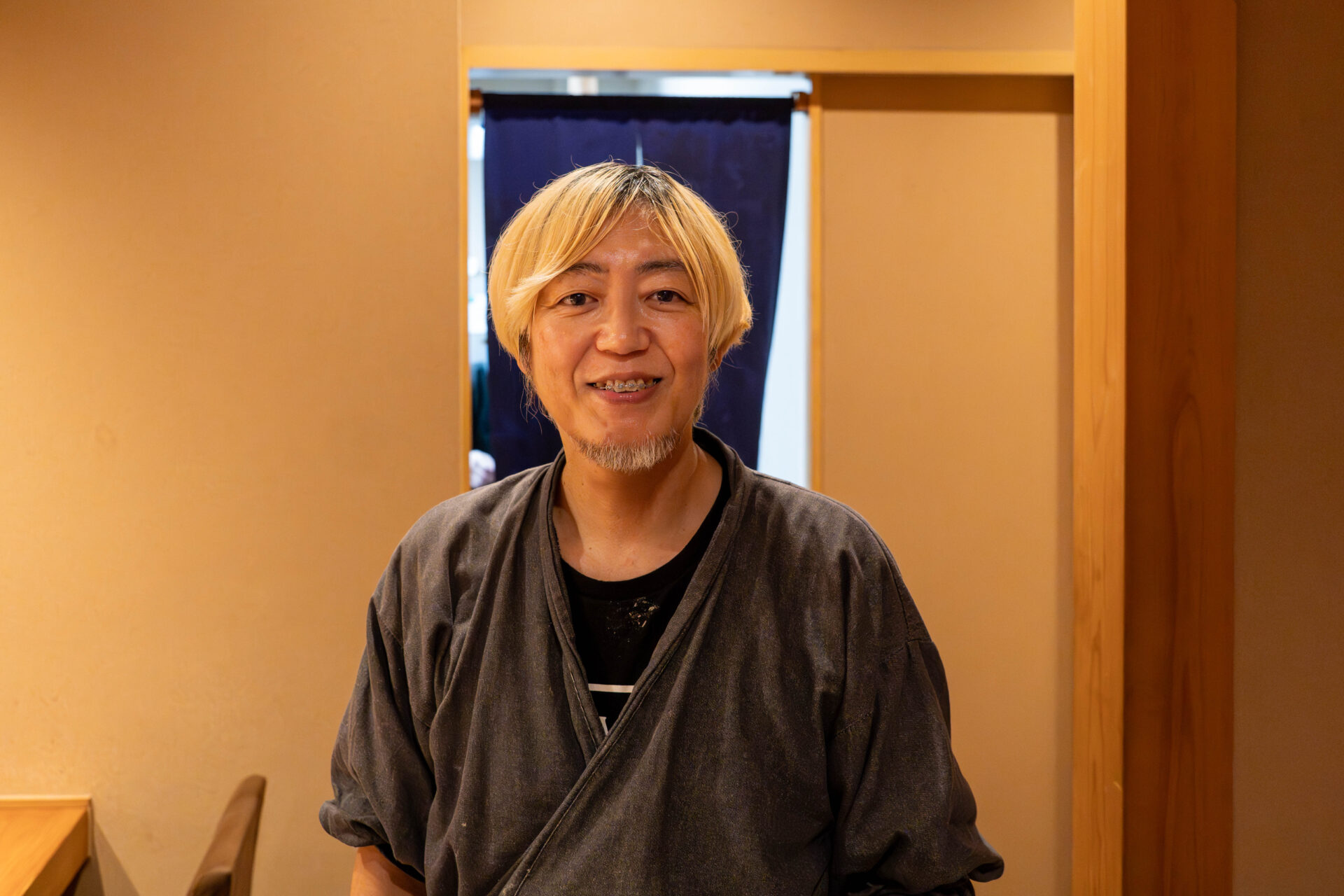
Reservations & Access
How to Book
“Tempura Takeuchi” is reservation-only. Bookings are taken by phone only, and you must call in advance before visiting. If you will be late, they ask that you call without fail. With limited seating, it’s wise to confirm course details and serving times when you reserve.
Opening Hours
Lunch 12:00–14:00; dinner 18:00–22:00, both served in two seatings. Closed on Mondays; may close during Golden Week, Obon, and New Year holidays. As it is reservation-only, plan your visit according to the hours.
Access Information
-
Address: 6-64-1 Imagari, Nakagawa City, Fukuoka Prefecture
-
Phone: 092-953-1699
-
Nearest station: about a 15-minute walk from Hakata-Minami Station (JR Hakata-Minami Line).
-
By car: roughly 20 minutes from the Dazaifu Interchange.
-
Parking: on-site parking available (2 spaces)
- TAGS

